Record-breaking number of visitors
Winner of Museums and Galleries National Award

Registered by Australia Post. Publication No. VBH 7236 The magazine of the Jewish Holocaust Centre, Melbourne, Australia
April 2012 Jewish Holocaust Centre
JHC Board:
President: Pauline Rockman OAM
Vice President: Adam Kreuzer
Immediate Past President:
Shmuel Rosenkranz
Secretary: Elly Brooks
Treasurer: David Cohen
Public Officer: Helen Mahemoff
Members: Allen Brostek, Alex Dafner, Abram Goldberg, Sue Hampel, Paul Kegen, Henri Korn, Willy Lermer, Ruth Mushin, Goldie Birch
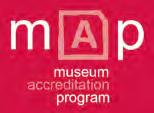
JHC Foundation:
Chairperson: Helen Mahemoff
Trustees:
Nina Bassat AM
Joey Borensztajn
Allen Brostek
Silvana Layton
Jeffrey Mahemoff AO
Patrons:
Professor Yehuda Bauer
Mrs Eva Besen AO
Mr Marc Besen AO
Sir William Deane AC CBE
Sir Gustav Nossal AC CBE
Mrs Diane Shteinman AM
Steven Spielberg
JHC Staff:
Warren Fineberg, Executive Director
Zvi Civins, Director of Education
Jayne Josem, Curator, Head of Collections
Michael Cohen, Community Relations Coordinator
Reuben Zylberszpic, Development Manager
Phillip Maisel OAM, Head of Testimonies
Sabina Josem & Rose Freilich, Librarians
Daniel Feldman, Project Administrator
Lena Fiszman, Office and IT Manager
Tosca Birnbaum, Reception
Claude Fromm, Assistant Archivist
Rae Silverstein, Volunteer Coordinator
Centre News Editorial Commitee:
Editor: Ruth Mushin
Pauline Rockman OAM
Michael Cohen
Lena Fiszman
Jayne Josem
Fay Helfenbaum
Reuben Zylberszpic
Moshe Ajzenbud (Yiddish)
The Jewish Holocaust Centre is dedicated to the memory of the six million Jews murdered by the Nazis and their collaborators between 1933 and 1945.

We consider the finest memorial to all victims of racist policies to be an educational program which aims to combat antisemitism, racism and prejudice in the community and fosters understanding between people.
On the cover:
Survivor guide David Prince with students from Vermont Secondary College in the Jewish Holocaust Centre museum
Photo by Izi Marmur
w: www.jhc.org.au
Selwyn Street Elsternwick Vic 3185 Australia t: (03) 9528 1985 f: (03) 9528 3758 e: admin@jhc.org.au
13–15
OPENING HOURS Mon–Thu: 10am–4pm Fri: 10am–2pm Sun & Public Hols: 12pm–4pm Closed on Saturdays, Jewish Holy Days and some Public Holidays JHC Centre News Disclaimer: The opinions expressed in Centre News are those of the authors and do not necessarily reflect those of the magazine editor or editorial committee. While Centre News welcomes ideas, articles, photos, poetry and letters, it reserves the right to accept or reject material. There is no automatic acceptance of submissions. This publication has been designed and produced by Izigraphics Pty Ltd www.izigraphics.com.au
From the President 3 Editor’s letter 3 D irector’s cut 4 Education 5 Jewish Holocaust Centre celebrates prestigious MAGNA award and record number of visitors 6 From access to integration: digital technologies and the study of Jewish history 7 Chasidei Umot HaOlam 9 Elliot Perlman: writing about history, memory and human rights 10 Good Living Street 12 Remembering the Shoah is not enough 13 Surviving the Cap Arcona disaster 14 The healing process 15 Faith 16 A time to remember 18 Introducing Reuben Zylberszpic and Dominik Armellini 19 Valuing laughter: the role(s) of humour in Holocaust films 20 Kristallnacht commemoration and special tribute to Shmuel and Betty Rosenkranz 21 Light in the darkness: the Jewish and Hellenic experience of rescue 21 Celebrating 65 years since the arrival of the SS Johan de Witt 22 Mazal tov to Phillip Maisel, Willy Lermer and Fred Steiner 2 3 Book reviews 24 JHC Social Club 26 Friends of the Jewish Holocaust Centre 2 7 Seen around the Centre 28 Stories from the Collection 3 0 New acquisitions 31 Twins celebrate their bar mitzvah by giving to the Jewish Holocaust Centre 3 2 Celebrating Kitia Altman and Sabina Josem 3 3 Obituaries 34 Community news 3 6
CONTENTS
Pauline Rockman OAM
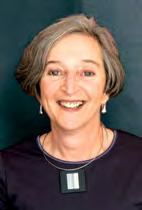
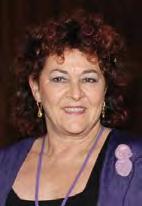
The year 2012 was ushered in at the Jewish Holocaust Centre (JHC) with much fanfare. We are basking in the afterglow of the fantastic acclaim generated by our museum receiving a 2011 Museums and Galleries National Award (MAGNA). It is a well-deserved honour for the recently refurbished museum. Congratulations to our dedicated team ably led by Jayne Josem, Curator and Head of Collections.
Last year over 20,000 students visited the museum. There was also a marked increase in general visitors. Our numbers are ever-increasing, a tribute to our Executive Director Warren Fineberg, Education Director Zvi Civins, and our dedicated survivors, staff and volunteers.
The 27 January is the date designated by the United Nations as Holocaust Memorial Day, following the recommendation of the International Task Force for Holocaust Education. It was first observed in 2006. The JHC observes the day annually in line
EDITOR’S LETTER
with that UN resolution. This year our keynote speaker was The Hon Josh Frydenberg MP.
Holocaust Memorial Day, a worldwide commemoration of the Shoah, provides the opportunity to learn from the Holocaust, from Nazi persecution and from the subsequent genocides such as those which have occurred in Cambodia, Bosnia, Rwanda and Darfur. It also looks to the future, to educate subsequent generations about the Holocaust and the continued relevance of the lessons learnt from it. The recognition by many countries of this day inspires me and gives me a measure of hope in today’s world, a world fraught with difficulties and a great degree of pessimism.
The focus of Holocaust Memorial Day 2012 was ‘Speak Up, Speak Out’. Its message was to think about the responsibility we all have to speak up when we see or hear something which we believe to be wrong, to speak out against the injustice, discrimination and hatred which happen around us.
How will the Holocaust be considered by future generations? How do we maintain the precious legacy passed on to us by the survivors? These questions confront and challenge us.
Indeed, my grandchildren will be part of the last generation who will actually have the privilege of meeting
Holocaust survivors. At the JHC we have recorded much testimony, which we have incorporated into our museum. Many programs are being developed to utilise these testimonies. They, albeit sadly, are the future.
On meeting my special friend and mentor Kitia Altman recently, my sixyear-old grandson Julian remarked: ‘You know Kitia?’
‘Yes,’ I said.
‘She fought in the Holocaust.’
‘I know,’ I replied.
Kitia, a Holocaust survivor and longtime guide at the Centre, recently celebrated a very special birthday. The JHC was delighted to host a morning tea for her and another dedicated volunteer, Sabina Josem, who also celebrated a special birthday. We are so grateful for their wonderful contribution to the Centre over many years and look forward to their continuing involvement. Their wisdom is invaluable to us, the second and third generation. Chag Pesach sameach!
Speaking recently at the Jewish Holocaust Centre, author Elliot Perlman mentioned the controversy that has raged for decades over whether African-American troops were part of the armed forces that liberated Dachau concentration camp in April 1945. During question time, one survivor told of his experience of seeing black soldiers on the day
Dachau was liberated; another survivor, of seeing black soldiers at Buchenwald the day after liberation; and yet a third, of collapsing at the gate of a satellite camp of Mauthausen on the day the camp was liberated and being carried on a stretcher to the camp hospital by ‘two black giants’. Their accounts were not only moving, but provided direct evidence through their eyewitness accounts, reinforcing the importance of survivor testimony.
These personal stories are central to the Jewish Holocaust Centre. Survivor guides share their experiences with school students and other visitors in the museum every day, but their stories can also be found on the museum display panels, video screens and Storypods.
Their stories are also stored in the testimonies collection and they are here in Centre News. In this edition we feature three very different stories by Holocaust survivors: Kitia Altman writes about the Righteous Among the Nations – those nonJews who risked their lives to save Jews during the Holocaust; Sarah Saaroni writes about how sculpture helped her to heal the wounds of her wartime experiences; and Jack Fogel writes about surviving the Cap Arcona disaster – the accidental bombing of Nazi prison ships by the British Air Force at the end of the Second World War.
These stories are both informative and inspirational. A visit to the Centre’s award-winning museum will expose you to many more.
JHC Centre News 3
FROM THE PRESIDENT
Ruth Mushin
Warren Fineberg
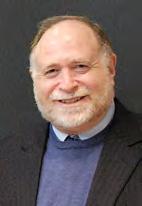
It was a great pleasure to attend the Museums Australia national conference in Perth at the end of last year, and especially to receive the national MAGNA award for our museum installation. Congratulations to Jayne Josem our curator and the many survivors, volunteers and staff who made this award possible.
Since the last edition of Centre News, the Jewish Holocaust Centre (JHC) has maintained a busy calendar of events. In November, we marked the 73rd anniversary of Kristallnacht, incorporating the Betty and Shmuel Rosenkranz Oration at a commemorative function at the Glen Eira Town Hall. In collaboration with B’nai B’rith Victoria and the National Council of Jewish Women of Australia, Victoria, the commemoration included a presentation scripted by Cedric Gould, presented by John Lawrence, Ruth Yaffe, George Werther and Rabbi Philip Heilbrunn OAM, and directed by Esther Gross.
‘Sculpture and Memory’ was the title chosen for a special night at the Centre. Renowned sculptor Andrew Rogers spoke about the inspiration and motivation behind his ‘Pillars of Witness’ sculpture at the entrance of the Centre. Andrew is an internationally recognised artist whose critically acclaimed sculptures are housed in numerous private and public collections in Australia and overseas. He
also created ‘Rhythms of Life’, the largest contemporary land art undertaking in the world, forming a chain of 48 massive stone sculptures (or geoglyphs) around the globe. At the function, Holocaust survivor and celebrated sculptor, Sarah Saaroni, whose works feature prominently throughout the Centre’s museum, discussed the nature and symbolism of her work and how sculpting gave her a voice to express the unspeakable.
At the beginning of this year we bade farewell to Sebastian Hausleitner. Sebastian chose to do ‘service abroad’ as an intern at the Jewish Holocaust Centre in place of serving in the Austrian army. His interest and activities in Holocaust education in his home country pointed him in the direction of our Centre in ‘far away’ Australia. At the Holocaust Centre Sebastian was involved in the film club, general maintenance, office administration, event organisation, and with a special project he initiated called ‘The Library Goes Web’. He has done himself proud and has been a credit to his family and his country.
Sebastian introduced our new intern, Dominik Armellini, who arrived in February, to survivors, volunteers, guides and staff. Dominik will undertake a number of projects, including completing ‘The Library Goes Web’ project.
Two important projects are currently underway with significant progress to be made during 2012. Generous support from the Telematics Grant will see the building of an ‘app’ which will extend the experience of students who have visited the museum and spoken with our survivors and guides. A second grant, coordinated by Apel, Meerkin
and Associates, will allow for research, translation, cataloguing and providing access through special web facilities to materials we hold about the Lodz Ghetto. I am particularly excited about both projects, as each aims to place otherwise inaccessible material into the hands of researchers and the public.
The Annual Pearl Recht Teachers’ Seminar, held in February, is an important program coordinated by the JHC Education Department. We are grateful to the respected teachers and academics who give of their time to deliver lectures and workshops. This allows us to support the work of classroom teachers in their pursuit of excellence in teaching.
The JHC Social Club is an initiative which has developed out of the Thursday Club. Barbara Sacks and Max Wald have made an outstanding effort to prepare a program of interesting speakers for 2012. Whereas the Thursday Club catered for retired survivors and guides, the JHC Social Club has become more inclusive and is intended for all guides, volunteers and retirees.
Reuben Zylberszpic has settled into his work as Head of the Development Department. Major tasks ahead of him are to place a bequest program into operation, this being the most significant support for Centre operations, and reconnecting with past supporters. I extend an open invitation to those of our readers who have not visited our museum recently to do so, to bring a friend (or friends) and to see the outstanding developments which have taken place at our Centre in recent times.
Exhibition of Auschwitz drawings
Kevin Maxwell is a photo realist artist who visited Auschwitz-Birkenau for the first time in 2005. Like other tourists, he took many photographs, but after returning to Australia the following year, he completed drawings of those photos. These drawings will be on display at Edges Gallery, 324 Glenhuntly Road Elsternwick 3185 from 19 April for two weeks.
For further information about Kevin Maxwell visit his website at www.kevinmaxwellsfineart.com
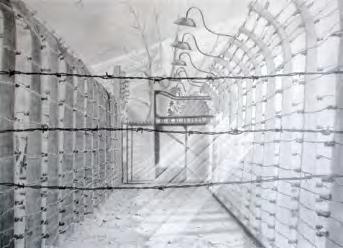
JHC Centre News 4
DIRECTOR’S CUT
‘Hope’ by Kevin Maxwell
EDUCATION Zvi Civins

During the recent Australian Tennis Open we often heard Roger Federer referred to as ‘the greatest tennis player of all time’. But wait: Raphael Nadal consistently beats him, most recently in the semi-final at the Australian Open. So doesn’t this make Nadal the greatest of all time? But wait again! In January Novak Djokovic beat Nadal in the final of the Australian Open, and it was his third straight grand final victory over Nadal! So doesn’t this make Djokovic the ‘greatest of all time’?
Who is the greatest of all time? How often we engage in this neverending debate! Who is the greatest artist, writer, musician, or leader? The debate is never-ending if not outright futile. So why then do we do it? It seems to reflect our need for absolute certainty, the certainty that this person whom we revere as the greatest is, in fact, the greatest – even though every other person with a different ‘greatest’ can argue his or her case just as powerfully as we do ours. By identifying and defining our ‘greatest’ we attach ourselves to his or her greatness. We identify in ‘the greatest’ those qualities we revere and which we wish we possess, or in our hubris imagine possessing. Perhaps our ability to argue the case for our ‘greatest’ makes us just that little bit ‘greater’.
When discussing the Holocaust we often find ourselves falling into this same pattern of thinking. I often hear or read from any number of sources or people, ‘The Holocaust
was the greatest genocide of all time. It was unique. It was the worst.’ Why do we do this? What purpose does it serve to proclaim that the Holocaust was worse than any other genocide, whether Rwanda, Cambodia, Armenia, or Darfur?
Is it even possible to compare tragedy and suffering? There are those who say that the Holocaust ‘was the worst’ on the basis that Germany was such an advanced society, yet they perpetrated such inhumane acts. But does the perpetrators’ level of education, their degree of ‘culture’, however this is defined, make the suffering of the victim worse than someone else’s suffering?
Others often refer to the sheer scale of the Holocaust. Are the deaths of six million ‘worse’ than two million, or one million? According to the Talmud, he who saves a single life saves an entire world. If one life is like a world full of people, the number of victims doesn’t make one event worse than another.


Perhaps the Holocaust’s pre-eminent status can be ‘proved’ on the basis of the indifference of the rest of the world to it. Yet other genocides were met with indifference, and some at a time when the world could see clearly on a day-to-day basis just what was occurring.
Or perhaps it is in the participation of our neighbours with whom we had lived for centuries? Well, other genocides were carried out by neighbours, too.
We could go on and on, but in the end, we will not succeed in ‘proving’ anything. In fact, this need to define the Holocaust as ‘the worst’ doesn’t enable us to achieve our goal, which, according to the Jewish Holocaust Centre’s mission statement, is to educate: ‘We consider the finest memorial to all victims of racist policies to be an educational program which aims

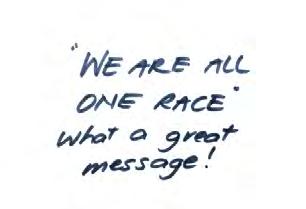
to combat antisemitism, racism and prejudice in the community and foster understanding between people.’ Fixating on this need to prove that the Holocaust was the worst genocide of all time sends a message to others who have suffered in their own way that their suffering does not equate to ours. Such a message alienates others.
Roger Federer is a great tennis player, an athlete who brings a unique beauty to the game. Raphael Nadal is also a great tennis player, and we can marvel at his strength and physicality. Novak Djokovic is a great tennis player too, whose determination is absolutely inspiring. We can recognise each man’s greatness, as well as the greatness of Steffi Graf, Martina Navratilova, Chris Evert, Billie Jean King, Margaret Court and many other men and women who have graced the tennis courts of the world. There is room in our hearts and minds for all of them.
The Holocaust is the Jewish people’s greatest tragedy. It is a tragedy the likes of which the world had never seen, but the nature of which the world has seen. We recently observed the United Nations Holocaust Memorial Day commemoration. We recalled other victims of the Holocaust. While the Holocaust remains an essentially Jewish tragedy, we acknowledge the suffering of others.
Rather than engage in this futile competition of who suffered more, let us make room in our hearts for others, as we can for multiple tennis greats. Perhaps instead of saying that our suffering was the worst, we should instead say: ‘We suffered terribly. You suffered too.’ Let us acknowledge our respective suffering, understand its causes, and use our knowledge to help ensure that others do not suffer as we both did.
JHC Centre News 5
Jewish Holocaust Centre celebrates prestigious MAGNA award and record number of visitors

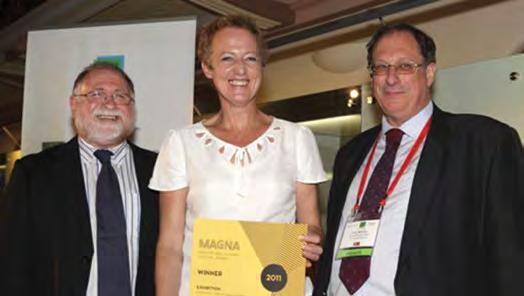
In November 2011 the Jewish Holocaust Centre (JHC) received the inaugural MAGNA (Museums and Galleries National Award) for a Small Museum Permanent Development (budget less than $25,000). The award was for the refurbishment of the Centre’s permanent exhibition space. The judges commented: ‘Such an empathetic development combined with impressive design principles, this project honours the purpose of the Jewish Holocaust Centre while providing a contemporary environment fusing technology and display that will enable it, through its exhibitions, to attract and engage existing and new audiences into the future.’
The refurbished museum opened two years ago, incorporating state-of-the-art technology alongside traditional museum displays. The renovations were undertaken principally because the old museum was in need of a face lift, but the real imperative was the need to keep the Holocaust survivors’ voices alive in the museum, with most survivors now in their eighties. Survivors have been the lifeblood of the Centre, volunteering in all areas, but most significantly as museum guides, talking to visitors about their experiences. This feature has been crucial to the Centre’s success, so the challenge was to ensure that visitors to the museum would continue to learn about the Holocaust directly from the stories of survivors.
In renovating the permanent museum space, a key aim was to ensure that the display would communicate effectively to young people. At the same time the museum had to appeal to all ages, because the universal message of the Holocaust is not limited to school students. The aim was for a more modern design to make the challenging content more easily palatable, but also to incorporate multi-media to captivate students and other visitors.
According to the exhibition designer, Martin Lilford of Lilford Smith: ‘The museum has been designed to guide visitors through the Holocaust in the order events unfolded. Angular walls serve to break up the journey and help to reinforce thematic changes. The simplicity and consistency of the museum’s design aims to assist visitors to focus on the content, providing clarity and room for reflection. Images, documents, artefacts, audiovisuals and the written word have been woven together to engage and inform. The display is punctuated by artworks that bring direct expression and emotion to the indescribable. Ultimately the museum serves to educate and provide a message of hope.’
Although more radical options were considered, it was decided to retain the original layout, because we wanted the survivors who are still active as museum guides to feel comfortable with the layout, as we feel strongly that this is their museum.
The museum contains traditional text panels, documenting the chronological history of the Holocaust as well as highlighting themes such as the stories of some of the
‘Righteous Among the Nations’, that is, non-Jews who risked their lives to help Jews during that dark period. This narrative approach has not changed significantly from the original museum and is consistent with most Holocaust museums around the world. However, one feature that makes our museum unique is our large collection of original documents, photos and artefacts from Melbourne Holocaust survivors. As a result, we tell the story of the Holocaust through the experiences of the local survivor community.
We have incorporated technology to complement the traditional museum displays, but not to overwhelm them. Four screens with short clips from survivors recounting vignettes from their experiences can be found in the museum. There are also a number of ‘Storypod’ computer kiosks where visitors can explore survivor stories in depth. Other kiosks enable visitors to gain access to a range of other information, including a country-by-country exploration of the Holocaust.
The Centre has regularly attracted 15,000 annually. Since relaunching, however, the number of visitors has increased. A record 20,803 students from 485 schools visited the museum in 2011 (up from 15,617 in 2009 and 18,822 in 2010). An additional 5,557 other visitors came to the museum in 2011.
From its humble origins, the Centre is now a vibrant modern institution with a world-wide reputation for its excellent programs. The new display has been built upon the foundations that the original survivors created and ensures it will continue to play a vital role in educating the Victorian community about the horrors of the Holocaust, as well as universal themes of human rights and tolerance in society today.
If you have not already visited the museum, we hope you will do so very soon. Details of opening hours can be found on the Centre’s website at jhc.org.au.
JHC Centre News 6
(l-r) Warren Fineberg and Eileen Wright receiving the award from Dr Darryl McIntyre, President, Museums Australia, at a ceremony in Perth, Western Australia
From access to integration: digital technologies and the study of Jewish history
Jayne Josem
Irecently had the privilege of being invited to a conference at the Center for Jewish History in New York City. The conference brought together senior representatives from some major collecting institutions, including the US Library of Congress, the Smithsonian Institution, the National Library of Israel and Oxford University’s Bodleian Library, as well as key representatives from leading universities working in the area of Judaica and cultural heritage. The idea was to discuss common problems and challenges for the study of humanities in the digital environment, focussing on Jewish archives in particular.
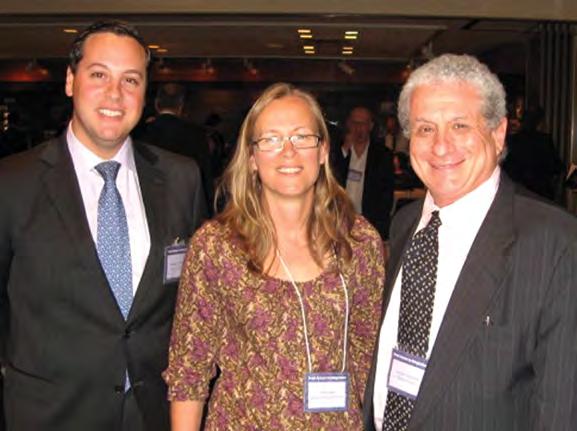
The key issue addressed was the need for global access to cultural heritage, which is becoming more realistic in the digital world. However, this new environment has created challenges for both the custodians of the cultural material and the public, including scholars, who desire access.
Deanna Marcum, Associate Librarian at the Library of Congress, noted in her address that the Library of Congress was one of the earliest institutions to embark on digitising primary source material in the early 1990s. That library now has 28 million items on its website, making the collection accessible not just to scholars but as a resource for all. The major challenge has been funding this initiative and establishing priorities about what to digitise.
One initiative undertaken by the Library of Congress has involved placing photos in the collection onto Flickr – an online photo management and sharing application – before they have been catalogued. Through this process the public is invited to provide information about the photos. The Library does not put this information into the catalogue record unless it has been verified under more rigorous examination. Nonetheless, this is an innovative use of a social networking site as a tool for information gathering, opening the institution up to a wider information universe.
Other questions surround the preservation of electronic resources, which is costly and uncertain. One such
question is what to collect in the digital environment, particularly in regard to ‘born digital’ material, such as multi-media, internet sites and blogs.
A number of organisations represented at the conference demonstrated their digital projects, including the Diarna Project undertaken by Digital Heritage Mapping Inc. This project uses Google Earth to map sites of Jewish history and incorporate into them 3D representations of sites that either no longer exist or are in a state of ruin. The project also includes archival photographs of the sites, hyperlinks to further information, and oral histories where appropriate.
Another large project, entitled ‘Judaica Europeana’, documents the representation of Jewish life in Europe. Funded by the European Commission, it features five million digital objects. Judaica Europeana works with cultural institutions to identify and provide online access to content, documenting Jewish presence and heritage in the cities of Europe. This content will be integrated into Europeana – Europe’s museums, archives and libraries online.
Gunter Waibel, Director of the Digitization Program at the Smithsonian Institution, spoke about the challenges associated with having 140 million items in the Institution’s collection. His advice was to ‘focus on a noble goal’ from which a strategy will emerge. He emphasised that collaboration can be transformative to all parties involved. One of the most significant ideas that emerged from his presentation was that just putting items on the internet does not equate to ‘meaningful access’.
The first session of the next day was about developments in the area of the Middle East. To put the challenge into context, the example was given of the Cairo Genizah, a collection of almost 280,000 Jewish manuscript fragments found in the Genizah or storeroom of the Ben Ezra Synagogue in Fustat, presently Old Cairo. They were mostly religious documents and books, destined for burial, as Jewish law forbids writings containing the
JHC Centre News 7
(l-r) Michael Glickman, Chief Operating Officer of the Center for Jewish History, New York City; Jayne Josem, JHC Curator and Head of Collections; and Douglas Greenberg, Executive Dean of the School of Arts and Sciences at Rutgers, The State University of New Jersey
name of God to be thrown away. Like many items relating to the Holocaust, the collection has been fragmented and dispersed into different libraries and archives around the world. Today 193,000 fragments are in the United Kingdom at Cambridge University, 31,000 fragments are in the Jewish Theological Seminary of America and a further 11,000 fragments are in Manchester. This creates challenges for scholars conducting research.
Oren Kosansky, Assistant Professor of Anthropology at Lewis and Clark College in Portland, Oregon, spoke to us about his discovery in 2005 of the Rabat Genizah, a much smaller collection, in a room in a Morrocan synagogue. With the approval of community leaders, Kosansky sorted through hundreds of sacks containing thousands of documents and determined which documents were appropriate for burial and which represented significant historical texts suitable for preservation. Synagogue leaders gave Kosansky the documents for preservation, and he donated them to the Jewish Museum in Casablanca. He sought funding to digitise the key documents and make them available to researchers the world over.
computer - into those languages for which this can be done. The project is awaiting development of a tool to search some of the other non-Latin alphabet languages such as Hebrew and Yiddish.
The next presentations addressed initiatives in the European sector, such as the Hebrew University’s Centre for Russian and Eastern European Jewry. The Centre is currently combining material harvested from local archives with a wealth of other material to gain a better picture of the history of Jewish life in this area. One example of the Centre’s work can be found in its website on Jewish Galicia (www.jewishgalicia.net). The problems highlighted included the question of ownership of items, the digitised versions of these items and the website content. Translation of material into English is expensive. The website has low-resolution images because the cost is lower, and the images can be better protected. Another challenge is whether institutions can ensure that the images are used responsibly by the public.

Rachel Heuberger, Head of the Judaica Division of the University Library in Frankfurt, provided a German perspective. She explained that as Jewish material had been invisible in the years following World War Two, the issue of visibility is now extremely important. The Judaica Division has been digitising its Judaica collection and has developed a site known as ‘Compact Memory’. It offers actual reproductions of important research journals for German-Jewish history and genealogy research, covering the entire German-speaking world.
The summary session at the conference was presented by Barbara Kirshenblatt-Gimblett, Program Director of the Core Exhibit at the Museum of the History of Polish Jews in Warsaw and a professor at the New York University. She hypothesised that the conference agenda had focused on digitising as much as possible and maximising access. However, she posited some challenges to this idea. The first was the obsolescence of technology and its implications. Like earlier speakers, she made the point that oceans of data and infinite access do not necessarily make material more accessible. She argued that data does not equal knowledge. What is the transformation that we are after? What is the tipping point from quantitative to qualitative?
‘There are so many issues up for consideration,’ Kosansky said. ‘For example, what, if any, are the copyright issues for such old documents? And what are the copyright laws in Morocco? Are there private documents we should not digitise out of respect for some individuals or the Jewish community? Who should be consulted on such ethical considerations?’ Furthermore, he queried who owns the digital publication of the material. Finally, he posed the general question of whether more access to archives is necessarily better. Simply putting material on the internet does not necessarily mean access if there are language or educational barriers, and no internet access. Simply having masses of material available quickly does not mean that the public is better able to digest it all.
Yaron Tsur, Head of the School of Jewish Studies at Tel Aviv University, spoke about ‘The Historical Jewish Press Website’, highlighting the challenges of working in a global environment with material in a range of languages. At present the website has digitised 25 newspaper titles from 18 countries, covering five languages. It incorporates OCR – optical character recognition or the recognition of printed or written text characters by a
She also made the point that we should not underestimate the importance of face-to-face interaction with humans who are specialists. We should see libraries and archives as social places, where people interact, and we should think about improved communication as well as better access to information. How does the meeting of technology and scholarship lead to new knowledge or new forms of knowledge? How does new knowledge have an impact on a field of study? Surely the digital environment should lead to a multi-media environment for scholars. There will be new forms of serendipity: instead of browsing the stacks there is digital browsing, using tagging – assigning a keyword to a piece of information, making it searchable by the public.
The focus of the conference had been on providing more access to more material, but the conclusion was that the real question to discuss is ‘Why?’ Finally there is an imperative for everyone ‘to get their own house in order’, and their own data in order, before being part of a wider ‘coming together’.
Jayne Josem is the JHC Curator and Head of Collections. Her attendance at the conference was funded by The Rosalky Professional Development Program and the Center for Jewish History, New York.
JHC Centre News 8
Center for Jewish History preservation laboratory
Chasidei Umot HaOlam
Kitia Altman
Chasidei Umot HaOlam, three words, three Hebrew words which in English mean ‘righteous among the nations of the world’.
I sometimes think that life is like a long string of footsteps in the sand. Each footstep of my past contains a part of my life, a memory. At one spot, closer to the beginning, there is a deep dark senseless hole containing a jumble of footsteps – footsteps that belong to others as well as to me. That hole is the Holocaust, and as I look back I have a feeling of anxiety and great concern.
How will this terrible human tragedy be understood when the generation of eyewitnesses has disappeared?
I fear that ‘Holocaust’ will remain a word without a face, without a voice and without a soul. The Holocaust was a well-organised process that set out to murder a chunk of humanity, not on political, economic or religious grounds but on the grounds of race. To me, the most profound horror of the Holocaust was its dehumanisation, of being sentenced to death from the moment you were born just because you were a Jew.
However, there were people who defied this horrific process. These ordinary, unknown people – some of them even antisemitic – gave priority to human beings rather than to the ideology of racism. Not many people had that privilege to be in hell and to find human beings who were kind and who put human dignity above everything else. These people helped to shape my life and I believe must be remembered together with the family and friends we lost. What they did for the people whom they rescued, and for humanity, is not sufficiently well understood. Theirs was not a rescue for financial gain, but one that came from the depths of their consciousness.
The Israeli Government gave the title ‘Righteous Among the Nations’ to those non-Jewish people who risked their lives to save Jewish people. It is a title that brings no knighthood or palace, but only a certificate made of parchment.
I am passionate that everyone understands the profound meaning of these words, but they are often misinterpreted. They are sometimes interpreted as ‘courage’, but acts of courage alone do not qualify a person to be Righteous. Courageous people, for example, may help rescue others, but Righteous not only rescue, but take responsibility for the lives of those whom they rescue. Righteous people during the Holocaust acted with full awareness that there may be no one left to claim the people they were helping, or that they could be caught, thus endangering their own lives and those of their families.
I had the privilege of knowing two Righteous Among the Nations – a privilege that has made me question if I would be able to rise to such a level of human compassion. Both were ordinary people who came from two very antisemitic nations at that time – Germany and Poland. Both would be surprised by being singled out as special and would ask, ‘What else could I have done?’ However, both did far more than just help other people.
Genia Pajak, a Polish mother of three children who lived in dire poverty, offered to save me by smuggling me out of the Bedzin ghetto in 1943. Instead I persuaded her to take my eight-year-old cousin Marusia (Tamar) Cygler and hide her. Genia consented, and in doing so committed herself to saving a life. She did not know Marusia’s parents, she did not know how her children would react, and she did not say that she first had to consult her husband.
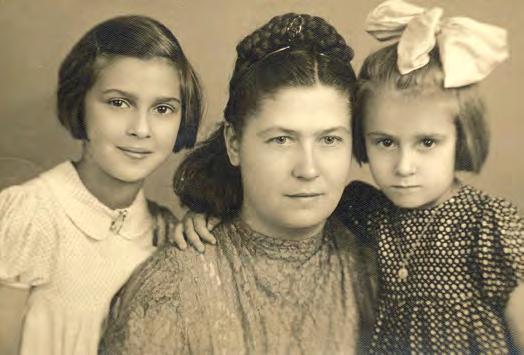
Alfred Rossner was a German. With a physical disability as the result of childhood polio, he was exempted from military service. However, in order to protect Jews in the Bedzin ghetto, he offered to establish a factory manufacturing uniforms for the Wehrmacht. This was the factory in which I worked. As manufacturing uniforms was considered a priority job, Rossner was able to obtain exemption from deportation for his Jewish workers and their families. Each worker with one of Rossner’s special passes was allowed to protect two family members: single people could protect their parents and married ones their spouse and child. Rossner was fully aware that he would be punished for his actions but nevertheless continued his work. He was murdered in a Gestapo prison in December 1943. Limping, slight, charismatic and clever, he played a double game with the Gestapo and paid with his life for his deeds.
I recently heard from my friend Hannah Miska, who worked at the Jewish Holocaust Centre as a volunteer but has now returned to Germany, that in 2010, at the cemetery in Falkenstein, the town in which Rossner grew up, a memorial stone was unveiled on 18 December (the day of his death in 1943) in his honour. His life story has also been incorporated into Falkenstein’s school curriculum.
I made a promise to myself in April 1945 that not only was the history of the Holocaust to be told, but that I would also tell the story of Genia Pajak and Alfred Rossner, those beacons to humanity and guardians of human dignity. Both have been honoured by the Israeli Government as Righteous Among the Nations.

JHC Centre News 9
Marusia Cygler (l) with Genia Pajak and her daughter, Sonia
Alfred Rossner
about history, memory and human rights
Fay Helfenbaum
Elliot Perlman is a Melbourne author. His first novel, Three Dollars , was the winner of The Age Book of the Year Award and his second, Seven Types of Ambiguity, was a critically acclaimed bestseller worldwide. His latest novel, The Street Sweeper, focuses on the Holocaust, among other themes. He has also published the award-winning short story collection The Reasons I Won’t Be Coming
In February the Jewish Holocaust Centre hosted ‘In Conversation with Elliot Perlman’. Elliot Perlman spoke with Australian Jewish News journalist Timna Jacks to a packed auditorium about his experience of writing The Street Sweeper. Here he speaks with Fay Helfenbaum.

When did you know that you wanted to be a writer?
I always wanted to tell stories, even when I was a child in primary school. I wrote a class play and I played in bands and wrote the songs. Reading became really important to me around eleven and twelve because I was very unhappy. I had changed schools and I did not have any friends at my new school. It was also the time when my parents split up.
I began reading more adult books and became hooked as I found so much comfort in reading. I began to devour different authors, which pleased my parents, as beforehand I had not been particularly interested in reading. I think that was because the books I had been given were the kind of classic English children’s books like those by Enid Blyton. My mother was an English teacher and the only books I was not permitted to read were those on her bedside table because she needed them to teach. Of course, for an eleven-yearold the only books you want to read are the books you are not allowed to read! So I began reading A Day in the Life of Ivan Denisovich by Solzhenitsyn and I was hooked. Then I thought that if I could give even one person the kind of comfort that certain books have given me, that would be a very worthwhile thing to do. It did not occur to me then that it was possible to earn a living from writing. Writing is a craft; you are not born being a good writer or storyteller, but the more you read and write the better you get.
I loved literature, music and cinema, but I studied politics, economics and law at university. However, I kept writing, and it was not until I was thirty that I won The Age
short story competition, which led to my writing being published. Eventually my Australian publisher contacted me to ask if I had a novel and I lied and said I had. I had the idea for a short story about a man who saw a woman every nine and a half years, four times in his life, the most recent time being when he was in his thirties, when he only had three dollars. As I was writing the story it became longer and longer and I thought that maybe this could be ‘the novel’. That story ended up becoming my first novel, Three Dollars
You obviously did a lot of research about the Holocaust for your new novel, The Street Sweeper. What was it like to hear all those harrowing stories?

Most of the research was reading, which is harrowing enough, but I always knew that I would eventually want to go to Poland to visit the places my family came from and to see the camps. My book became the focus for visiting Poland and I found it incredibly difficult. I went to Auschwitz six times. I felt I needed to go that many times because it was so affective emotionally that whatever I took in, or was told, or saw, or read, it was not possible to absorb it all. I broke down each time, but it was always as the result of something different.
I did not feel I needed to go to Auschwitz so much to learn facts that I could not find in books. It was more that I was intimidated by the prospect of writing about the Holocaust and thought that if I could go there and immerse myself in the place as much as possible, I could try to make it somewhere that I felt I could know. Now I know that that is impossible to do. Auschwitz today is nowhere near as big as the whole enterprise was in the 1940s. What a lot of people do not realise is that Auschwitz was made up of Auschwitz I and Auschwitz II (Birkenau), Auschwitz III (Monowitz) and over forty sub camps, which took up an area just under half the size of Manhattan. Quite apart from its size, you cannot know what Auschwitz was like if you were not there, as it was so far away from ordinary human experience, so it is impossible to know what it was like. The best you can do is approximate it through reading and, I felt, by going there as many times as was consistent with writing my book in a reasonable time.
I was very lucky to discover Robert Novak. Robert is a Polish Catholic who is a Yad Vashem-trained guide from the Auschwitz State Museum. His whole family is from the
JHC Centre News 10 Elliot Perlman: writing
Elliot Perlman and Edith Grynspan
town of Oświęcim, which was originally a predominantly Jewish town. Robert’s grandparents had told him that on bad days during the Second World War they could smell the burning in the centre of the town, so it is quite wrong for people to believe that the world did not know what was happening. Robert and I became friends and he was one of the few people to whom I disclosed the plot. He felt that it was terribly important that I tell this story. I confided in him my doubts that maybe I was not up to it and it should be told by a better or more famous writer. However, with Robert’s encouragement, grace, humour, warmth, knowledge of languages and his intimate knowledge of the history of the camp I was able to keep going. The other incredibly important thing he did for me was to introduce me to the last surviving Polish Jewish member of the Sonderkommando (group of prisoners assigned to dispose of the bodies of other prisoners who had been murdered), whose Holocaust experiences became the basis of the experiences of my character Mr Mandlebrot. The book would have been completely different without my good fortune to have Robert introduce me to this man. We filmed the interview and Robert translated it for me. Although it was difficult, I would remind myself that my experiences were nothing compared to the Jewish experiences of the forties. Do you remember when you first learned about the Holocaust?
I have always been interested in Jewish history, especially in the Holocaust, because I still cannot comprehend it. When I was researching, particularly in Auschwitz, I would spend the day there, from morning till evening, and go back to my hotel in Krakow and would still be stunned by it. Then I would do things connected to my own continuing existence – eating, sleeping, showering, checking emails – and I would wake up the next morning and still be shocked. You never become inured to it.
Social justice seems to be a continuing theme in your work.
I think that if you have the opportunity to be heard or read, it is not a bad thing if it can be a little bit in the
service of enlightenment and not only for the purpose of entertainment. Sometimes the reader does not know anything at all about your subject, sometimes the reader knows vaguely, sometimes the reader has forgotten, and sometimes the reader knows everything but feels alone. By having it there in story form readers can feel like they are not alone, or not crazy, and it can give them comfort by reminding them that there are other people who share their views.
What do you hope readers will take away from your books?
With The Street Sweeper in particular I would like readers to know what happened in the Holocaust and in the American civil rights struggle. I also want them to be reminded of the fundamental humanity of each person, no matter where they come from or what they look like, and to be reminded of the connection between people that you would not ordinarily even imagine existed. These connections can be between people that you know or that you do not know very well but are living near you, but they can also be between you and people that came before you that you might not think about. We need to realise just how closely connected we are to our predecessors, our ancestors.
How do you think your Jewish identity shapes your writing?
I think it shapes it almost entirely. I am not a religious person, but I feel extremely Jewish as I have felt all my life. It has affected my outlook on the world and the desire to write stories with a social justice background or message, although I am always concerned not to hit the reader over the head with my message. The story has to come first, but there I definitely have a social justice agenda. Sometimes I am barely aware of it and sometimes I am very aware of it. It is a product of my Jewishness that comes from my family, my background and our culture, which is very much about trying to make the world a better place.
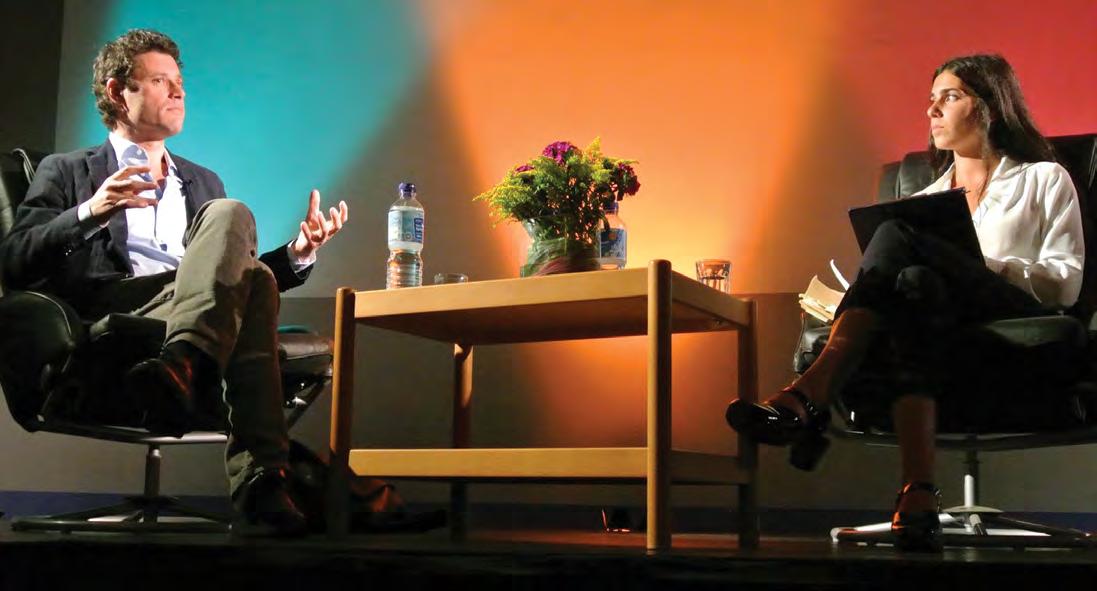
JHC Centre News 11
Elliot Perlman in conversation with Timna Jacks
Good Living Street
Tim Bonyhady
Tim Bonyhady’s great-grandparents were leading patrons of the arts in Vienna. The family’s lavish lifestyle came to an abrupt end in 1938 when they fled Vienna for Australia, taking with them the best private collection of art and design to escape the Nazis. In his book Good Living Street: The Fortunes of my Viennese Family (Allen & Unwin, 2011) Tim Bonyhady follows the fortunes of his family from patrons of the arts to refugees from the Holocaust; from high society in Vienna to a small flat in Sydney.
Fin de siècle Vienna is renowned for art and design, for literature, ideas, design and paintings, for Sigmund Freud, Gustav Mahler, Arnold Schoenberg, Josef Hoffmann and Adolf Loos, and of course Gustav Klimt. It is not particularly well known for science or technology. But in the 1890s Carl Auer von Welsbach put Vienna at the forefront of technology. He invented the first colour camera and the first incandescent metal-filament electric light bulb, and most profitably he invented the gas mantle. In a period where Thomas Edison had invented the first carbon-filament electric lights, there was intense competition between electric and gas lighting. And from 1890 up to almost 1910, Auer von Welsbach shifted lighting back from electricity to gas.
The gas mantle went global and anyone who became involved early in the new technology in a significant way grew rich. Among those people were my greatgrandparents, Moriz and Hermine Gallia. They married in the main synagogue in Vienna in 1893 – a marriage between an uncle and his niece (which we would now find shocking but which then was unusual though far from entirely so), a marriage between a man 12 years older than his wife (which was quite conventional among members of the upper middle class). Moriz and Hermine came from successful families in Moravia and Silesia. They were part of that extraordinary influx of Jews into Vienna in the second half of the nineteenth century which saw the
Jewish population of Vienna rise from almost nothing to about 10 per cent of the population and saw Jews play a crucial role in the creation of what we now think of as Vienna 1900, that era of cultural greatness in Vienna which ran from about 1898 until 1918. As Stefan Zweig put it, ‘nine-tenths of what the world celebrated as Viennese culture … was promoted, nourished, or even created by Viennese Jews.’ Riding on the back of the gas mantle business, Moriz and Hermine grew seriously wealthy and became major patrons of the new culture.
The Vienna Secession art movement was founded in 1897 and almost certainly Moriz and Hermine bought their first paintings from the Secession in 1898 when it held its first exhibitions. In 1902 Moriz bought The evil mothers, now regarded as Giovanni Segantini’s masterwork, as a foundation painting for a modern gallery to be established by the Austrian government in Vienna. In return, Moriz gained a title.
When Moriz became a Regierungsrat, a court councillor, the family immediately set about getting themselves painted. Moriz was painted by Ferdinand Andri, who was one of the rising stars of the Secession. So were the four Gallia children – my grandmother Gretl, great-uncle Erni and great-aunts Käthe and Lene. Gustav Klimt, who was by far the most famous portrait painter in Vienna, never painted men and generally did not paint children. But the Gallias did get Klimt to paint Hermine, probably giving Klimt the commission in 1901.

In 1903, Hermine and Moriz were members of Vienna’s Jewish community, the Israelitische Kultusgemeinde, but their four children had been baptised. In 1910 Hermine and Moriz followed suit. For Hermine, who had been educated by nuns, even though her father Nathan played a leading role in Jewish organisations, it seems the move to Catholicism was one of genuine attachment. For Moriz, as with many Jews of the period, it seems to have been a pragmatic decision, hoping that conversion would give

JHC Centre News 12
Moriz and Hermine Gallia after their marriage at Vienna’s main synagogue in 1893
Ferdinand Andri’s portrait of the Gallia children, 1901
his children better prospects and safeguard them from the antisemitism which they confronted. (When Moriz died, his charitable bequests were, notably, to Jewish institutions, not Catholic ones.)
In 1903, Klimt’s portrait of Hermine was first exhibited at the Secession. In the same year the Wiener Werkstätte, the famous Viennese craft workshops, were established and Hermine acquired her first of many pieces of the Werkstätte’s work. Moriz and Hermine knew what was chic and were at the forefront of fashion.
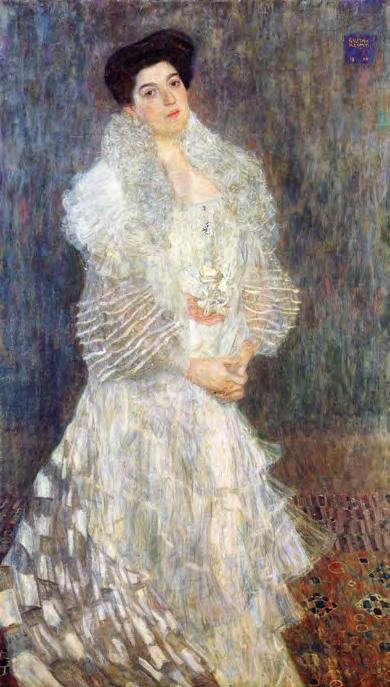
Having lived for the first 20 years of their marriage above the main gaslight showroom, Moriz and Hermine bought a block of land on the Wohllebengasse (Good Living Street). In an era when Vienna was notorious for everything being either neo-gothic or neo-baroque or neo-renaissance or neo-something else, in a very deliberate kind of display of their difference, the Gallias erected their house at number four. It was designed by Franz von Krauss, who won a prize from the city of Vienna for its modernism and restraint. The foyer was typically much more spectacular and upstairs was different again. The five front rooms of the apartment overlooking the street were the work of Josef Hoffmann, one of the founders of the Vienna Werkstätte. These rooms were examples of what is known as Gesamtkunstwerk – rooms where almost everything in them, including the light fittings, chairs, tables and carpets were designed by Josef Hoffmann. Within these rooms was the family’s spectacular collection including two Klimts – marking the Gallias as serious collectors of modern art – as well as works by Koloman Moser and Hoffmann’s student Wietzmann. There were many nouveau riche people in Vienna who bought modern art to give themselves a kind of veneer of culture and taste. That may well be how Hermine and Moriz started, but they sustained their patronage for 20 years. They began buying their paintings in 1898. Shortly after they commissioned the apartment in 1913, when the Vienna Werkstätte almost went broke, Moriz became a shareholder and then a director and then chairman of the board. He served as chairman until his death in 1918. That is something you only do if you have genuine commitment to an art movement and want to see it survive and prosper.
Much of my family’s collection was in the Vienna: Art and Design exhibition at the National Gallery of Victoria, including the Klimt portrait of Hermine which is now owned by the National Gallery in London. What that exhibition did not show, however, is the ugliness and horror of their lives. When the family moved to Vienna in the late nineteenth century there had been a period in the 1870s and 1880s when antisemitism was at a relatively low point in Viennese terms. But from the 1890s through the first three decades of the twentieth century, it increased and kept on increasing, most shockingly following the Anschluss (the Nazi annexation of Austria) and Nazi occupation.
A fortnight after the Anschluss in March 1938, my great aunt Käthe was arrested by the Gestapo and put in a police prison for seven weeks. In November 1938, my grandmother Gretl, her daughter and my mother Annelore (later Anne) and Käthe managed to obtain visas and escape Austria. They came to Australia by ship, settling in Sydney. My mother brought with her a copy of the hideous, antisemitic publication The Eternal Jew because she wanted always to have with her a physical object which would remind her how lucky she was to escape.
My maternal grandfather, Paul Herschmann, who had separated from Gretl, could not obtain a visa. The only way he could escape was to enter Belgium illegally. In 1939, with the help of individuals now generally dubbed people smugglers, he escaped, but his two older brothers, Gustav and Franz, did not. In May 1942 the Nazis put Gustav in a convoy from Vienna to Maly Trostinec in Belorussia. Almost all the members of this convoy were forced to take off their clothes, stripped of their valuables and shot in front of open trenches. Franz, who was Paul’s favourite brother, was picked up by the Vichy police in a mass roundup of Jews in mid-1942 and sent to Auschwitz where he was gassed.
Paul survived in hiding in Vichy France during the war. When he re-established contact with my mother in 1948, he wrote that since 1939 he had lost 27 kilos. He was undergoing electric shock treatment and he wrote that almost every night he dreamed of the last time he had seen his brother Franz.
The record of Australia when it came to Jewish refugees was poor. Australia prided itself on being 97 or 98 percent British-Australian and wanted to remain that way. So it imposed quotas and only a fraction of the number of Jews who wanted to escape were able to come here. When they arrived there were wonderful people who treated my family with extraordinary generosity and took them into their homes. Quakers were at the forefront of doing so. But there were other people who thought of them as ‘refos’ or ‘bloody refos’ or ‘refo bastards’. For all their obvious hatred of the Nazis, they were ludicrously soon designated as ‘enemy aliens’ because they arrived with German passports. They were placed under police surveillance, and there were repeated calls for the federal government to intern all of them. They were always under intense pressure to assimilate which, for someone like my grandmother, who was already in her forties when she arrived here, was impossible, but for someone like my mother, who was aged just sixteen when she reached Sydney, was much more possible.
JHC Centre News 13
Tim Bonyhady is a cultural historian and environmental lawyer at the Australian National University. This is an edited version of his address at the Jewish Holocaust Centre in August 2011.
Gustav Klimt’s portrait of Hermine Gallia, 1903
Surviving the Cap Arcona disaster
Jack Fogel

Jack Fogel was born in Turek, Poland. He was one of five children. When the Second World War broke out he was almost fifteen and had just finished his seven years of compulsory schooling. When the Germans occupied Turek, the family was forced to live in a ghetto. The following year Jack was forced onto a truck and taken to Poznan. He worked in labour camps in the Poznan area until 1943, when he and other prisoners were transported to Auschwitz and then to Fürstengrube, a nearby labour camp. Jack was the only member of his family to survive the Holocaust. He has been a volunteer guide at the Jewish Holocaust Centre for 13 years.
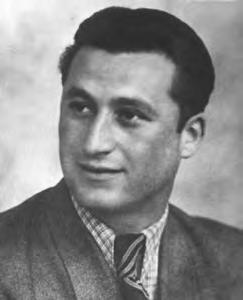
In mid-January 1945, as the Soviet army was advancing, the inmates of Fürstengrube were marched away from the camp. It was minus 20 degrees and snowing, and the roads were icy. We only had thin clothes and wooden clogs and the guards beat us to make us walk faster. We walked for two or three days and anyone who could not walk anymore or fell was shot straight away. One morning we were not given anything to eat and I was really hungry. I felt my knees go and thought ‘that’s it’. But the two fellows next to me picked me up and dragged me along, and somehow I regained my strength and kept on walking. If I had fallen it would have meant certain death.
At Gleiwitz we were forced into open-top coal wagons to begin a horrific rail journey through Poland, Czechoslovakia and Austria. The guards squeezed us in so tightly that we could only stand up and could not move. It was freezing cold and we had no shelter. People who could not stand any more would sink to the ground and were trodden on by others. The dead were thrown out of the wagons to create space for the living. We had no food and tried to catch snow to eat. Many hundreds of prisoners died.
We arrived at Mauthausen concentration camp and thought that this would be the end of our journey, but we were refused entry to the camp and the train continued north to Mittelbau-Dora, another concentration camp. A few days later, our group – decimated by over 50% – was loaded onto coal trains again and brought to Blankenburg in the Harz mountains, where we were forced to build the camp of Turmalin. In early April, as the Allies came closer, we were forced to march again, this time to Magdeburg. There we were shipped down the River Elbe to Lubeck, and then marched to Neustadt, a village on the Baltic Sea. When we reached Neustadt, we could see ships, perhaps 500 metres away. We did not know what was going on,
as nobody would tell us. Eventually they divided us into two groups and took us on barges out to the ships. Half of the surviving AuschwitzFürstengrube prisoners were put on the Cap Arcona and the rest, including me, were put on the Athen. The ships were already crowded with other prisoners. I was literally thrown down to the bottom of the ship. It was dark, cold and wet. I had one blanket – my only possession – and I was starving. I was at the stage where I was so hungry that I could not feel hunger any more. I just lay there, half dead, and could not care less what would happen to me.
After some time we heard bombs and explosions. One of us managed to climb up to the deck and he came down again to tell us that the ship had been taken to the port and deserted by the German guards. One by one, and very slowly, we all climbed up the ladder. At the top we saw smoke and flames all around us, and in the sea there were bodies and people swimming.
It was not until later that we found out that three ships –the Cap Arcona, Thielbek and Athen – had been stationed in the Baltic Sea as transport for the German army fleeing westward from the advancing Soviet army. The ships were then commandeered to take concentration camp prisoners on board. Although it is not clear what the Nazis intended to do, some historians assume they had the intention of sinking the ships and murdering the prisoners.
However, on 3 May 1945, before the Germans could carry out their plans and just four days before Germany surrendered, the Royal British Air Force bombed the ships, believing them to be German troopships. Tragically the British were unaware that the ships were filled with innocent victims. Those prisoners who did not drown or burn to death jumped into the freezing water and were shot at by German soldiers. Over seven thousand prisoners died. The Athen was the only ship to escape the bombing.
Only a few hundred prisoners survived the death march and what later came to be known as the ‘Cap Arcona disaster’. I am one of them.
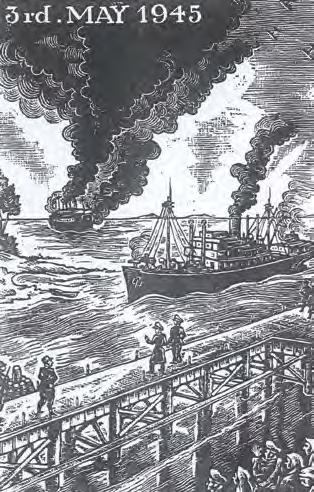
JHC Centre News 14
Etching of the Cap Arcona disaster by Walter Preisser
Jack Fogel in 1947
Jack Fogel
The healing process
Sarah Saaroni
Sarah Saaroni was 13 when the Second World War broke out. Her family lived in Lublin, Poland. The family was first forced to live in the Lublin ghetto, then went into hiding. By the middle of 1942 Sarah’s parents had arranged false non-Jewish papers for her and she travelled to Germany to work. Working in Hamburg for the Germans, she was betrayed and interrogated by the Gestapo. She escaped and was recaptured and interrogated again and was jailed for a month. In autumn 1943 Sarah escaped from a transport to Majdanek concentration camp. She worked under a different name near Dresden and was liberated in early spring 1945. After returning to Poland, she migrated to Palestine in 1946, joining the Haganah and fighting in the 1948 War of Independence. In Israel she married and had two children before migrating to Australia in 1953. After retiring from work she became a wellknown sculptor. She is the author of Life Goes on Regardless … (1989).
In December 2011
the Jewish Holocaust Centre held a ‘Sculpture & Memory ’ function at which Sarah Saaroni spoke about how she became a sculptor.

In 1943 I was taken in by a German family in Grossröhrsdorf, near Dresden. After work in a factory during the day I used to make animals and little figurines from wax, the remains of candles, whenever I could find any. My first encounter with real art was in Rome in 1945, when I was on my way to Palestine. I went to Rome a couple of times with my brother, Julek, and was fascinated when I saw the magnificent sculptures there. I envied the artists who created them and wished that I could sculpt. However, it was not until after I retired that I finally made the move towards fulfilling my dream. In 1981 I enrolled in a combined pottery and sculpture class and was very excited to hold clay in my hands for the first time in my life. I had big expectations, but by the end of the lesson I was disappointed. All we did was pottery and I wanted to learn how to sculpt. For the next lesson I took a figurine to class and tried to copy it. The first piece I managed to make exploded in the kiln, but the second one came out right. I was so happy that at last I had found my life-long vocation. After the first term I stopped attending the class and started to work from home. I had many difficulties and I was so frustrated, but I spent every single free moment I had working at it.
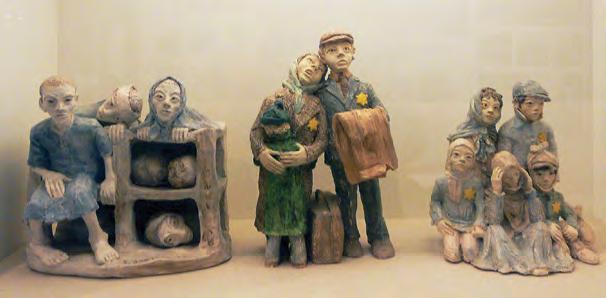
Someone suggested that I take some lessons from Karl Duldig, a well-known sculptor. He did not normally give lessons, but he could see that I had some talent and was
interested. At my first lesson I learned a lot about how to work with clay, how to handle it for sculpture and how to build a figure. During the second lesson, however, Karl gave me some clay and asked me to start and see what would come out. As I am not able to create something on the spur of the moment, I became clumsy and tense. By the end of the lesson I explained that I could not work under pressure and would be better off working on my own.
Several months later I had some more lessons from another sculptor, Yvonne Goodman, but I could not continue as she lived too far away from my place. Yet I had learned something from both sculptors. Karl Duldig had taught me the first steps in how to handle the clay, and Yvonne had taught me the fine points, the finishing touches. From then on I continued working alone, learning from my mistakes.
I tried to recreate the pre-war Jewish way of life, the shtetl – the unique characters I remembered who were wiped out by the Nazis. In 1983 I created my first piece about the Holocaust. I do not know what inspired me to do it, but there was something inside me trying to get out, and it became an obsession. I became a workaholic and dedicated every moment I could to art.
Several months later I invited Karl Duldig to see my work and he told me: ‘Your work is like storytelling.’ And that was exactly what I had tried to do – to tell stories, to make my figures talk. It was the beginning of my healing process.
Karl Duldig advised me to slow down and not to produce so many pieces, but I did not really care if my work was good or not. I had the urge to work, to create as much as possible, to compensate for all the years I had lost. For the first time I could talk about my past and transfer my memories into sculptures.
Today my greatest satisfaction is this art, which I had first practised on candle wax in Grossröhrsdorf, and then so admired in Rome. Sculpture was my first step towards being healed, but it was not until I wrote my story that I felt free and able to talk about my past. It took me fortytwo years to let go. Time and art healed my wounds, but it could not be rushed.
JHC Centre News 15
Sarah Saaroni (centre) with her daughter Adina Kleiner (right) and granddaughter Elisse Kleiner (left)
Sarah Saaroni’s sculptures in the Jewish Holocaust Centre museum
Faith
Michael Cohen
The young people of today are born into the ‘I’ generation, a generation of iPhones, iPods and iPads. Their generation is marked by individualism in an era in which science and technology and the scepticism of Dawkins and his ilk are all-pervasive. One may believe that these young people would eschew issues relating to faith. The argument is well known: the world is changing ever faster. In a single generation there is more scientific and technological advancement than in all previous centuries since human beings first set foot on this earth.
However, in unchartered territory, one needs a compass and, for many, that compass is faith. Indeed, I have found in my teaching and more recently in my work at the Jewish Holocaust Centre that this generation of youngsters, no less than others, is in search of meaning which transcends those things which can be empirically validated by science and technology.
I am constantly confronted by students with the conundrum of God’s seeming absence during the Holocaust, which Commonwealth Chief Rabbi Lord Jonathan Sacks has termed ‘a mystery wrapped in silence’. These students, Jewish or not, struggle with issues of faith, as did those who survived the catastrophe. I have no magic solution to their battles with theodicy – the attempt to justify or vindicate a just, compassionate and merciful God in light of human suffering. While Jewish students are introduced to the gamut of biblical and rabbinic approaches to human suffering, it is sometimes the simple stories that demonstrate the strength of people’s faith in adverse circumstances. These stories speak louder than textual exegesis or theological and philosophical speculation which grapple with the interminable questions of ‘Where was God at Auschwitz?’ or ‘Where was Christ?’ Where was Christian mercy and compassion in a Holocaust which occurred in the heart of Christendom?’ or, perhaps most significantly, ‘Where was man?’
Elie Wiesel, Holocaust author and Nobel Peace Prize laureate, recounts the trial of God, a din Torah (judgement according to the Torah). During the Holocaust, which he calls ‘The Kingdom of Night’, three rabbis, all erudite and pious men, decided to indict God for allowing His children to be massacred – for turning His back in silence on His people in their greatest hour of need. The trial lasted several nights. Witnesses were heard, evidence was gathered, conclusions were drawn, all of which resulted in a unanimous verdict: the Lord God Almighty, Creator of Heaven and Earth, was found guilty of crimes against creation and humankind. And then, after what Wiesel calls an ‘infinity of silence’, one of the scholars looked at the sky, noting that it was late, and said, ‘it is time for evening prayers,’ at which the members of the tribunal rose and recited Ma’ariv, the evening service. What is also
perhaps significant in the context of the trial is the fact that the Ma’ariv service opens with the words ‘vehu rachum yechaper avon velo yashchit’ – ‘He, the Merciful One, is forgiving of iniquity and does not destroy.’
The ‘trial of God’ is really a trial of faith. That is why the rabbis prayed: they are torn between their devotion to God and their abject disappointment in His silence: a paradox, perhaps, but one in which faith is not abandoned.
Perhaps another story, a true story, will serve to confirm the strength of an individual’s faith. Just three months before he died in 1978, Naftali Stern visited Yad Vashem on Yom Hashoah (Holocaust Remembrance Day). Naftali, a man in his late 70s, took out an envelope containing frayed pages; written on them were the prayers for the Jewish New Year Additional Service (Musaf L’Rosh Hashanah), one of the longest services in the Jewish liturgical tradition. Prior to the Second World War, Naftali had lived in Satu Mare, North Transylvania, Romania, with his wife Bluma and four young children. In May 1944, Naftali, Bluma and their children were deported to Auschwitz. Upon their arrival, Naftali was separated from his family. Bluma and the children were murdered in the gas chambers and Naftali, considered strong at 34 years of age, was sent to Wolfsberg, a forced labour camp in Germany. There the inmates were forced to dig tunnels and trenches to serve as a defensible bunker for the retreating German army and high command.
As the Jewish New Year approached, Naftali reflected upon the Rosh Hashanah services. He sold his daily ration of bread in order to obtain a pencil and some empty sacks that had held cement. He tore the paper sacks into small squares and began to write, from memory, the entire Rosh Hashanah service in a scrawl.
A Nazi officer in the camp allowed the inmates to gather together and hold prayers for Rosh Hashanah in lieu of breakfast. Naftali, who by virtue of his sweet voice had been a cantor in Satu Mare, led the services. It was an event the survivors remember as a special moment in the life of the camp.
Naftali hid those handwritten pages on his body until his liberation. Each Rosh Hashanah, for the next 30 years, he held the crumbling pages as he prayed.

After the war Naftali rebuilt his life, established a new family and immigrated to Israel. He decided to donate the disintegrating papers to Yad Vashem for safekeeping. When presenting them he stressed that it was vital that future generations understand that in spite of the survivors’ harrowing experience during the Holocaust many, like him, had maintained their faith.
Moshe Fiszman, who works as a survivor guide at the Jewish Holocaust Centre, has become my friend. When I
JHC Centre News 16
began working at the Centre last year he would often enter my office and, knowing my love and passion for chazzanut (cantorial music), would chant the beginning of two wellknown prayers he recalls from attending synagogue in Radom, Poland, before the Second World War. He recites both prayers – ‘Habeit mishamayim urei’ (‘look down from heaven and see’), and ‘rachem’ (‘have mercy’) – with bitterness, given his shocking, unspeakable experiences during the Holocaust. And yet, when he addresses students he sometimes concludes his testimony by donning a skull cap and reciting the shema – the watchword of the Jewish faith, acknowledging God’s oneness.
Is there any logic to faith? Should there be?
While in Israel in October 2002, the heading of an article in the Jerusalem Post by journalist Tom Tugend caught my eye. It was a short piece about Elie Wiesel titled ‘The man who never divorced God’. In his seminal book, Night, Wiesel wrote: ‘Never shall I forget those moments which murdered my God and my soul and turned my dreams to dust. Never shall I forget these things, even if I am condemned to live as long as God Himself. Never.’ Later, in his essay titled ‘The Death of My Father’, penned many years after the Holocaust and thus after his father’s horrific death in Buchenwald, Wiesel agonises whether or not to mark his father’s yahrtzeit (anniversary of death), given the circumstances of his father’s death. While Wiesel rails against a ‘cruel God’, an ‘imposter God’, and ‘the God of dead children’, he nevertheless ultimately submits himself to the centuries-old Jewish tradition and observes his father’s yahrtzeit in accordance with the prescriptives of halachah (Jewish law). Faith wins out.
Faith somehow triumphs too in that incredible short story, albeit fictional, set in the last days of the Warsaw Ghetto uprising. Written in 1946 by Zvi Kolitz and titled ‘Yossel Rakover Speaks to God’, the story purports to be the last testament of the son of a Ger Chasid – a deeply pious man – fighting in the Warsaw Ghetto, a man who
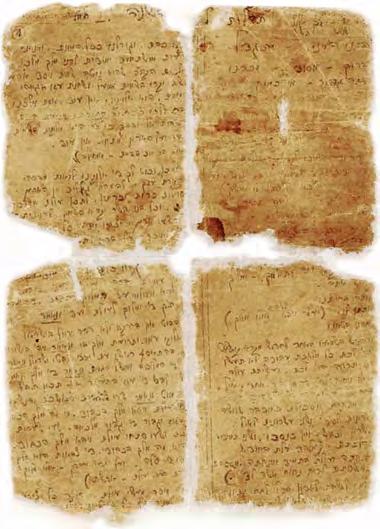
refuses to relinquish faith in God. His experiences are those of a hunted Jew, a survivor of a German air assault that killed his wife, infant child and two children, and the terrible depravations of the ghetto that claimed his last three children. As a man of profound faith, the cruelty he suffered turned all certainties upside down. He lashed out at the world that seemed determined to annihilate him but his faith remained unshaken even though his relationship with God was deeply compromised.
Yossel is the last fighter alive in one room in one house in Warsaw in 1943. His desperation elicits a proud affirmation:
‘I believe in Israel’s God even if He has done everything to stop me from believing in Him,’ adding that ‘I bow my head before His greatness, but will not kiss the rod with which He strikes me.’
In the 1830s Alexis de Tocqueville, French political thinker and historian, lamented that faith – specifically religious faith – was bound to die down in the face of the Enlightenment sweeping western Europe. Today there are those who argue similarly. Perhaps I am an eternal optimist in my steadfast belief that, despite the individualism of the current generation, there is an ongoing search for faith which transcends technology and science. ‘Faith,’ writes Jonathan Sacks, ‘confounds prediction.’ It is surprisingly persistent.
I believe that faith, with its rich ethical and spiritual base, is the bedrock of our society. As such, I hold that it is the sacred obligation of teachers – whether in synagogues, temples, parishes, formal educational institutions, or as parents or significant others – to instil in the younger generation the wonder of a faith, though tempered with doubt, which nourishes the soul and looks with optimism to the future.
Michael Cohen is Community Relations Coordinator at the Jewish Holocaust Centre. This is an edited version of a keynote address he delivered at the annual Jewish Community Council of Victoria and Anglican Diocese of Melbourne Annual Dinner in October 2011.
Asociaţia Tikvah, Oradea, Romania
Asociaţia Tikvah is a not-for-profit organisation established in 2010 by a second and third generation family of a Holocaust survivor in Oradea, Romania. Oradea, or Nagyvárad in Hungarian, is in the area of northwest Romania known as Transylvania, a few kilometres from the Hungarian border. It was once the home of a vibrant Jewish community and by the 1940s close to one third of the population of 90,000 was Jewish.
Oradea’s Jewish population was decimated during the Second World War. In 1942, men were forced into slave labour and in 1944 the Nazis incarcerated the Jewish community in ghettos. Within weeks they were transported to Auschwitz, where most were murdered.
Around 2000 Jews returned to Oradea after the war and today only a few hundred remain.
Asociaţia Tikvah has been established to collect material relating to the Jewish community and the Holocaust in Oradea, and to conduct educational projects relating to human rights and the Holocaust. The organisation is currently scouring the world for survivors, or families who lost loved ones who had some connection with, or memories of, Oradea.
If you have any connection or information at all about the Jewish community of Oradea, Asociaţia Tikvah would like to hear from you. Please contact Mariana-Emilia Teszler by emailing associationtikvah@gmail.com or visit the website at www.tikvah.ro
JHC Centre News 17
A facsimile edition of the Rosh Hashanah prayer service handwritten from memory by Naftali Stern on paper torn from cement sacks in the Wolfsberg Labor Camp. Image: Yad Vashem
A time to remember
Josh Frydenberg MP

The 2012 commemoration of International Holocaust Memorial Day was held at the Jewish Holocaust Centre (JHC) in January. The audience included representatives of non-government organisations, Jewish community organisations, Federal, State and local government and members of the diplomatic corps.
Having visited Yad Vashem only weeks ago, the images of the Holocaust are fresh in my mind. Losing great-grandparents in the camps and with a wonderful great aunt with a number tattooed on her arm living only streets away, the pain of the Holocaust for my family, like so many others in our community, has been all too real.
On this visit to Yad Vashem I accompanied colleagues from both sides of the political divide, and the profound impact on them was both deeply and visibly emotional. Like other fair-minded people the world over, they are determined to see the Holocaust properly commemorated so that this horrific episode is never forgotten or repeated. That is why 27 January is so important. This date has been designated by the United Nations General Assembly as International Holocaust Remembrance Day, for on this day in 1945 the largest concentration camp, Auschwitz-Birkenau, was liberated by Soviet forces. With 104 states, including Australia, co-sponsoring the resolution in 2005, the United Nations’ action was widely acclaimed.
The world will not forget the 6 million Jews who perished together with millions of others, including Poles, Roma and Sinti, homosexuals, people with disabilities, Jehovah’s Witnesses, political and religious leaders and Soviet and other prisoners of war, at the hands of the brutal Nazi war machine.
These people were not casualties of war but the victims of an evil, ideological crusade designed to eliminate the Jewish people systematically and achieve what Professor Yehuda Bauer called ‘a global-racial hierarchy with the Nordic peoples of the Aryan race on top’.
The Holocaust was unique in scale and scope as the Nazi campaign marked every one of the 11 million Jews in Europe for destruction. It made no difference if you were one of the more than 3 million Jews in Poland or one of only 200 in Albania.
In the end over 90 percent of Polish Jews were killed, 75 per cent of Germany’s Jews and more than 50 per cent in Hungary, Romania and Belgium. These numbers include up to 1.5 million children, some of whom were exposed to horrific medical experiments.
Millions of Germans were involved in this effort. From bureaucrats to bankers, from teachers to train drivers, and the many German corporations that provided the means for exterminating millions of people, these civilians, like the soldiers in uniform, were not simply following orders. They were accomplices.
We, the descendants of Holocaust victims, need to ensure
the perpetrators of these horrible crimes see justice, however late. We must also do all we can to educate today’s younger generation about the horrors of the Holocaust, for if we do not the tragedies of the past are doomed to be repeated.
Rwanda, Darfur, Cambodia and Bosnia were not isolated acts of violence, but were genocides too, for which the lessons of the Holocaust proved no deterrent. It is against acts like these that the international community must redouble its efforts to prevent similar tragedies in the future.
So too must the international community stand up to dangerous leaders like Iran’s President Mahmoud Ahmadinejad when he threatens to wipe Israel off the map. Equally, we must confront those that seek to deny that the Holocaust took place. From Iran’s hosting of an international conference on the subject to a smattering of pseudo-academics in France, Britain and the United States who seek to give credibility to their claims, the attempts to deny the facts of the Holocaust are neither benign acts of ignorance nor simple mischief making, but something far more sinister and deliberate.
The birth of the State of Israel has been the one seminal development since the Holocaust that represents the hope and renewal of the Jewish people. For it is Israel’s very existence as a strong, vibrant, democratic nation that is the real proof that Hitler did not win.
The task before us to commemorate the Holocaust and preserve the memories of those who perished grows ever more important and urgent. The eyewitnesses are leaving us one by one and it is only natural that with time memories will fade.
It is our challenge to remind the world constantly that among the good there is also evil. Communities that can produce the minds of Hegel and Mozart and the hearts of Schindler and Bonhoeffer can also produce the twisted and perverted thinking of Eichmann and Mengele, Himmler and Hitler.
When Soviet troops entered Auschwitz-Birkenau on 27 January 1945 one of the darkest chapters in the history of mankind may have ended. But it is now up to us to remind the world that the book will never be closed. To paraphrase Thomas Jefferson, eternal vigilance is the price of our freedom.
The Hon Josh Frydenberg MP is the Federal Member for Kooyong. This is an edited version of his keynote address to the 2012 JHC International Holocaust Memorial Day commemoration.
JHC Centre News 18
Dr Anne-Marie Schleich, Consul General of the Federal Republic of Germany and The Hon Josh Frydenberg MP
Introducing Reuben Zylberszpic
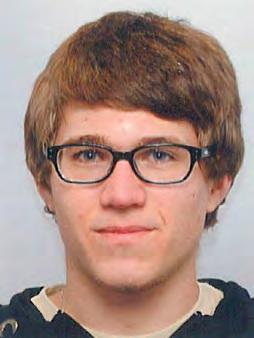
As the newly appointed Development Officer at the Jewish Holocaust Centre (JHC), I am looking forward to working with the wonderful staff and volunteers who have helped create one of the most respected museums in Australia.

Being the child of Holocaust survivors and an interviewer with Stephen Spielberg’s Shoah Foundation, I have a personal connection with the Centre and an abiding commitment to its mission.
My professional background is in the music industry and, while the role of Development Officer may seem a quantum leap from the music world, there are many skills pertinent to both. By developing projects and events at the Centre I aim to engage with the Jewish and broader communities. We are currently working to bring two exhibitions to Australia – one from New York in July and a major exhibition from Europe in February 2013.
Since opening in 1984, the hard work and dedication of a core group of volunteers (most of whom are Holocaust survivors) and staff, the JHC has survived and grown. It has done so whilst honouring its charter of teaching about the Holocaust and, in doing so, the dangers of racial intolerance in today’s world.
My most important task is to encourage individuals and businesses to support the JHC so it can continue its work as an educational, research and archival institution for many years to come. The simple truth is that without financial assistance the Centre will not survive. There are many ways the community can help, from the simple act of a one-off donation, to an on-going pledge or in the more significant form of a bequest, thereby leaving a permanent legacy for future generations. If you would like further information about donations or bequests to the Centre please phone me on (03) 9528 1985.
Introducing Dominik Armellini
have just begun an internship at the Jewish Holocaust Centre as part of the Austrian Holocaust Memorial Service (Gedenkdienst des Vereines Österreichischer Auslandsdienst), an alternative to Austria’s compulsory national military service or community service. I come from Dornbirn, a small city in Vorarlberg, the most western state of Austria. Although I am not Jewish, there are many reasons to remember and honour the victims of the Holocaust. These include never forgetting what happened in the past; building a responsibility for the future so it will never happen again; and creating awareness of the past by teaching what happened.
Austrian students learn about National Socialism and the Holocaust in secondary school. I was always very interested in history and for me these were two of the most interesting topics of the curriculum. When I was
Ififteen my class visited the former concentration camp of Mauthausen. Of course I had no sympathy for the Nazis before I went there, but the visit gave me a whole new level of understanding of the suffering the inmates endured.
I then began to inform myself more about the Holocaust and the politics of that period by reading, watching movies, going to the theatre and talking to people. A year later, my class visited the former concentration camp of Dachau, where prisoners from my state of Vorarlberg were incarcerated. By this time I had recognised that I was not heterosexual and, as between 5,000 to 8,000 homosexuals were killed by the Nazi regime just because of their sexuality, I began to wonder what would have happened to me. The more I learned the more I knew that we have to make sure that these times never happen again.
I decided to join the Austrian Holocaust Memorial Service as an alternative to military service. In preparation I read widely, visited museums, went to Prague to see the Jewish community and its cemeteries and visited Auschwitz.
I commenced my internship at the Jewish Holocaust Centre in February. I am pleased to be at the Centre and look forward to an interesting and productive time here.
Seeking information about Holocaust survivors
Do you know of Holocaust survivors Mrs Gerda Szneider, Mrs Nelli Kaula and Mr Friedrich Kaula, all originally from Germany? If you do, we would be grateful if you would contact Jayne Josem at the Jewish Holocaust Centre on (03) 9528 1985.
JHC Centre News 19
Dominik Armellini
Reuben Zylberszpic
Valuing laughter: the role(s) of humour in Holocaust films
Adam Brown
Hitler goes to a fortune teller and asks, ‘When will I die?’ and the fortune teller replies, ‘On a Jewish holiday.’ Hitler then asks, ‘How do you know that?’ And she replies, ‘Any day you die will be a Jewish holiday.’
This ‘joke’ is told by Robin Williams in the opening seconds of Jacob the Liar, a 1999 remake of the German film released in 1975. On face value, many (or even most) people will find more than one aspect of this discomforting, or perhaps just plain wrong. Can one laugh, or be asked to laugh, in the context of the physical destruction of European Jewry?
Should a Holocaust film starring Robin Williams even be made? The reasons for being dubious about such things are understandable; the Holocaust should never be appropriated merely for the sake of light entertainment. But can humour serve a purpose more valuable when filmmakers represent the ‘unrepresentable’?
Importantly, humour served as both a coping mechanism and a form of resistance during the war. Reflecting this fact, the narrator’s opening joke in Jacob the Liar is followed by the explanation: ‘That’s how we survived ... we relied on the little things: a dark joke, a sunny day, a hopeful rumour.’ The prevalence of humour in Holocaust cinema – present in both small and large doses in countless films – illustrates the different ways it can be used to understand and ‘work through’ traumatic events.
The ways in which humour works are as complex as they are varied. For instance, one issue that is almost never discussed in relation to Steven Spielberg’s Schindler’s List (1993) – a film about which everything else is discussed – is the subtle use of humour at various points throughout the story. The comedic banter shared between a group of Krakow Jews huddled together in the freezing ghetto serves to individualise and humanise the victims, revealing a brief moment of shared human dignity in the face of unprecedented persecution. At other times in the film, and more problematically, comedic conventions are used to belittle and pass strong moral judgement on the Jewish police.
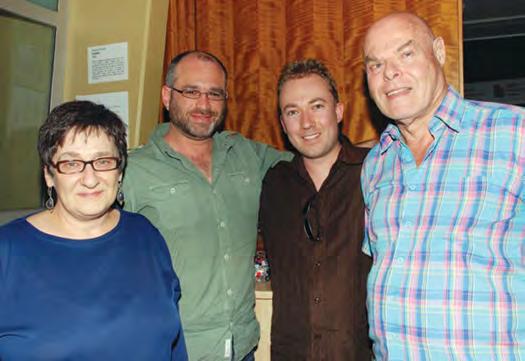
Examples of what might be called ‘Holocaust comedies’ continue to be made and re-made. To name but a few: To Be or Not to Be (1942 and 1983), The Producers (1968 and 2005), Life Is Beautiful (1997), Train of Life (1998) and the recent German production, Mein Führer: The Truly Truest Truth about Adolf Hitler (2007). In acknowledgment of this growing sub-genre, the Jewish Holocaust Centre (JHC) Film Club, a joint initiative of the Jewish Holocaust Centre and Deakin University, confronted this issue in 2011 through back-to-back screenings of two films released
five decades apart: Charlie Chaplin’s The Great Dictator (1940) and Michael Verhoeven’s My Mother’s Courage (1995). On both nights, guest speakers reflected on these films and led interactive audience discussions that revealed the intricacies of how and why laughter might be seen as questionable, controversial and important. The controversies surrounding ‘Holocaust humour’ are no more evident than in Chaplin’s satirical depiction of his Hitleresque character ‘Adenoid Hynkel’ and the whimsical Jewish barber who by chance replaces his tyrannical lookalike. Indeed, after revelations of Naziinflicted atrocities spread after the war, Chaplin himself expressed some doubt about whether or not he would have made the film had he known of the horrors that were to follow. Yet many viewers, including Bernard Korbman, who spoke to the Film Club’s audience in September, point out that comedy is a mode of representation that can capture aspects of the Holocaust that other ways of telling cannot. Given the placating attitude with which Hollywood producers generally approached the subject of Nazism both at the time and for many years after the war, Chaplin’s satire can be considered all the more biting. A scene in which he portrays Hynkel dancing lovingly with an inflatable globe, only to have it blow up in his face, works on many levels, from parody to prophecy.
In My Mother’s Courage, on the other hand, Verhoeven uses humour in considerably different ways to Chaplin. The film, a tragicomedy about the deportation of Hungarian Jews in 1944, negotiates the particularly sensitive issues of rape and so-called ‘Jewish passivity,’ while constantly exposing the history it constructs as an inevitably ‘artificial’ one. Dr Deb WaterhouseWatson of Monash University discussed the ways in which Verhoeven creates comedic scenes that comment on the absurdity of the enthusiastic collaboration of Nazi sympathisers, while making the more serious and sobering moments of the film stand out in their emotional intensity.
Much more could be said on this issue, and the JHC Film Club will undoubtedly be a forum through which similarly difficult, though equally interesting, subjects will continue to be addressed.
Please contact the Jewish Holocaust Centre or visit the website jhc.org.au for full screening details, or email Adam Brown (abrown@deakin edu au) to join the JHC Film Club mailing list.
JHC Centre News 20
(l-r) Lena Fiszman, Michael Barnett, Adam Brown and Frank Jackson
Kristallnacht commemoration and special tribute to Shmuel and Betty Rosenkranz
The Jewish Holocaust Centre (JHC) joined the National Council of Jewish Women of Australia (Vic), and B’nai B’rith Victoria in November last year to mark the 73 rd anniversary of Kristallnacht Held at the Glen Eira Town Hall, the program included a candle-lighting ceremony and a special presentation produced and directed by Esther Gross.
The JHC has traditionally honoured former president, Shmuel Rosenkranz, and his late wife, Betty, at an annual oration around the date of Kristallnacht. Living in Vienna in 1938 under Nazi rule, Shmuel was witness to the mayhem and destruction that occurred on that fateful night. Commonly known as the ‘Night of the Broken Glass’, Kristallnacht marked an intensification in the Nazi persecution of German and Austrian Jews that culminated in the Holocaust. On the night of 9-10 November 1938, 91 Jews were murdered, 7,500 Jewish businesses were destroyed, 267 synagogues burned, and hundreds of people injured. Approximately 30,000 Jewish men were rounded up, earmarked for torture, slave labour, brutal treatment and often death at the hands of the SS. The Third Reich’s Jews were then forced to pay one billion marks for what Nazi leader Hermann Göring called ‘their abominable crimes’.

At the commemoration, Jewish communal identity Malvina
Malinek OAM delivered a special tribute in honour of Shmuel and the late Betty to mark the JHC’s annual Shmuel and Betty Rosenkranz Oration. In her tribute, Mrs Malinek recorded the inordinate contribution which Shmuel and Betty had made to the Jewish community in so many areas of Jewish life. Having worked closely with Shmuel over many years, she noted his ‘eloquence and gentlemanly style’, his ‘love for the community and klal Yisrael’ (the Jewish world at large) and the ‘debt of gratitude’ which the Jewish community owes to him.
Light in the darkness: the Jewish and Hellenic experience of rescue
Dr Diamadis, an academic and exceptionally articulate presenter, recounted inordinate acts of bravery by members of the Greek community associated with attempts to save Jews. He gave the examples of the Archbishop of Athens and the Metropolitan of Zakynthos, who refused to surrender Jews to the Nazis. He also mentioned Greek smugglers hired by Jewish agencies who smuggled Jewish refugees from Romania to Britain and then to Palestine.
The function was attended by over 120 people, among them the Greek Ambassador to Australia, the Greek Consul-General, the honorary Consul-General of Poland and Australia’s Minister for Multicultural Affairs and Citizenship.

In August last year the Jewish Holocaust Centre (JHC), together with Return to Anatolia and the Child Survivors of the Holocaust group, hosted a special lecture by Dr Panayiotis Diamadis, Vice-President of the Australian Institute for Holocaust and Genocide Studies. The lecture was entitled ‘The role of the Greek underworld, the Greek Orthodox Church and other Hellenes in the rescue of Polish, Romanian and Greek Jews’.
It is estimated that in 1940 there were 77,000 Jews in Greece, most living in Thessaloniki (Salonika). Of the more-than 46,000 Jews deported to Auschwitz in 1942, fewer than 2,000 survived. Most of the 60 synagogues and Jewish schools were destroyed. An estimated 86% of Greek Jews were murdered by the Nazis.
JHC president, Pauline Rockman OAM, noted that the function served to cement the relationship between Return to Anatolia, the Jewish Holocaust Centre and the Child Survivors of the Holocaust. She highlighted the fact that the Greek and Jewish communities share a rich and diverse cultural history, as well as a history of suffering. She added that both communities have a long-standing friendship stretching back as far as the 4th century BCE and that both, as part of the wider Australian community, have contributed so richly and manifestly to the multicultural tapestry of Australian society. Both, she said, share a common goal: the eradication of bigotry and hatred, of racist ideology and discrimination.
JHC Centre News 21
Shmuel Rosenkranz
Photo: Dean Schmideg
Guest speakers and dignitaries at the Light in the Darkness function
Celebrating 65 years since the arrival of the SS Johan de Witt
Material concerning the arrival of the Johan de Witt in Australia and subsequent reunions can be found in the Jewish Holocaust Centre Collection. Sabrina Bednarski researched the material and Jayne Josem compiled this report.
In March 1947 the SS Johan de Witt docked in Sydney, bringing 702 Jews, the largest single contingent from Europe ever to arrive on one ship.
Mr D Absatz, envoy of the Jewish Welfare and Relief Fund, was reported as saying:
Customs officers had a shock when they opened the baggage to see the poor fortunes of these people ... Most of them had come with only a few old clothes. Their only desire was to be given the opportunity for a fresh start in life... (Australian Jewish News, 21 March 1947)
The newspaper reported:
There was one young man, Isaac Jacobowicz, from Kalisch (Kalisz) Poland. According to his shrunken facial features, he looked no more than 15. Actually he was 25. He told a touching story of seven grim years in ghetto and concentration camps. He had escaped from the Nazis on two occasions. His mother and younger brother were done to death by the Nazis in 1942. He was forced to march for ten days barefooted from Austria to Czechoslovakia to a concentration camp near Leitmaritz (Litomerice), near Theresienstadt. After his liberation on May 8, 1945 his life was one of wandering and DP Camps.
However controversy surrounded the arrival of the Johan de Witt as the Australian Federal Parliament fiercely debated Jewish immigration to Australia. According to Alexandra Fanny Brodsky, in In Pursuit of a Dream: A Time in Australia:
The Minister for Immigration, Mr Calwell, had been criticised for issuing 2,000 landing permits on compassionate grounds to survivors of the Holocaust who had relatives in Australia able to provide accommodation and help them find employment. He was also criticised for allowing such a large number of these immigrants to arrive in one go on the Johan de Witt and defended himself by saying that this ship was not of a standard adequate for carrying British migrants from the UK. Yet for Jewish migrants, the Johan de Witt was considered the most seaworthy vessel to have arrived up till then. At the United Nations, Australia’s generosity in allowing 2,000 people into the country on compassionate grounds was highly praised. The Hon Arthur Calwell MP was Australia’s first Minister for Immigration who worked with the Australian Jewish
community to arrange passages for Holocaust survivors. He was criticised by some for allowing too many Jewish immigrants into Australia, and by others for not allowing more. At the time he stated:
There is not one grain of truth in the story featured by the Sydney Daily Telegraph and the Melbourne Sun Pictorial that the Dutch ships Oranja, John Oldenbarneveldt and Johan de Witt have been chartered by a Jewish Relief Organisation to bring thousands of Jewish refugees to Australia … As for the Johan de Witt, Mr Officer [Keith Officer, Australian Minister to the Hague] has confirmed … that although a number of Jews are aboard it, they are travelling under conditions to which both Mr Officer and the Australian High Commissioner in London … agreed that British migrants should not be subjected … I am forced to the conclusion that the original story … was concocted in the Sydney office of the Daily Telegraph as part of a campaign to arouse the passion of racial bigots and to embarrass the Government. The seriousness and sinister character of this anti-Semitic campaign cannot be over-emphasised.
Among those on board was Yiddish actor and impresario, Shmuel (Sam) Migdalek, originally from Radom, Poland. Shmuel was incarcerated in the Radom ghetto and then sent to a nearby labour camp. He was deported to Auschwitz in July 1944 where he was selected for labour, before being sent to Vajhingen Concentration Camp in Germany and finally to Dachau, where he was liberated by the Americans. Soon after liberation Shmuel resumed acting in performances at the Feldafing DP camp. In 1946 he met and married Silvia Andacht, a fellow Holocaust survivor. Shmuel and Silvia decided to immigrate to Australia where Shmuel had an aunt. They arrived on 16 March 1947 aboard the Johan de Witt. Shmuel went on to become a leading light in the Melbourne Yiddish theatre scene.
In March 1967 the Australian Jewish Welfare and Relief Society (AJW&RS) organised a 20-year reunion dinner dance. Arthur Calwell was guest of honour. Nearly 200 people attended. Speaking at the reunion, Mr Hans Fischer, Treasurer of the AJW&RS stated: ‘Looking at you all gathered here, I cannot help remembering Europe in 1945-46 when we were all in DP camps or other such places, sitting on our suitcases and waiting for some country to open its gates and give us a chance to start a new and normal life.’ Arriving on the Johan de Witt 65 years ago marked the beginning of this new life for 702 Holocaust survivors.
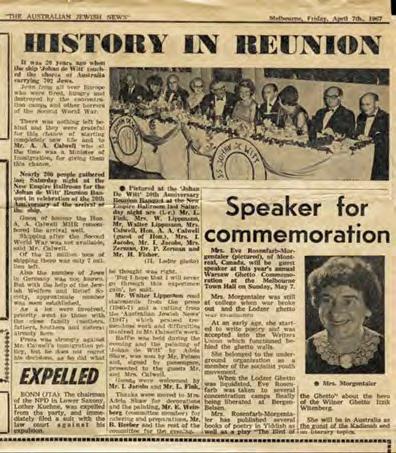
JHC Centre News 22
Article about the 20th anniversary celebration of the arrival of the Johan de Witt, Australian Jewish News 7 April 1967
Mazal tov Phillip Maisel OAM, Victoria Senior Achiever
Phillip Maisel OAM was recognised with a 2011 Victoria Senior Achiever Award at an awards ceremony at Government House in September 2011. The award was in honour of his work collecting testimonies from Holocaust survivors. The Hon David Davis MP, Minister for Health, commended Phillip for working diligently to create a legacy through the Jewish Holocaust Centre’s Oral Testimonies Project.
Phillip, a Holocaust survivor, has dedicated the last two decades of his life to videotaping testimonials of other Holocaust survivors. Since buying a video camera in the early 1990s, Phillip has recorded 1300 testimonies. He has also developed the Oral Testimonies Project for the Centre, gathering and preserving source material and eyewitness accounts. The project is a rich source of material for current and future researchers on the Nazi era. In March 2011, Phillip’s contribution to the Jewish Holocaust Centre was honoured by the official naming of the Centre’s testimonies collection as ‘The Phillip Maisel Testimonies Project’.
Willy Lermer and Fred Steiner receive JCCV Community Recognition Awards
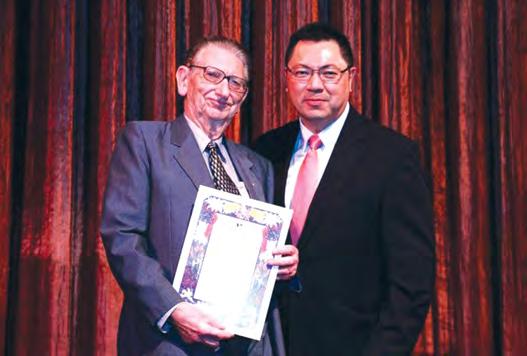
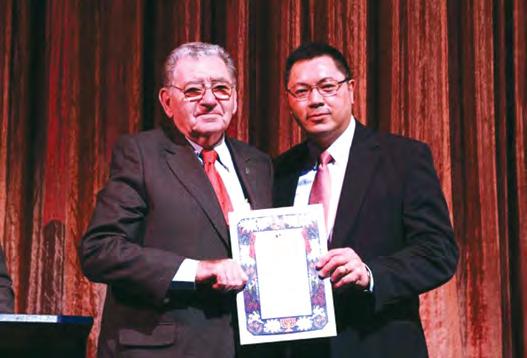
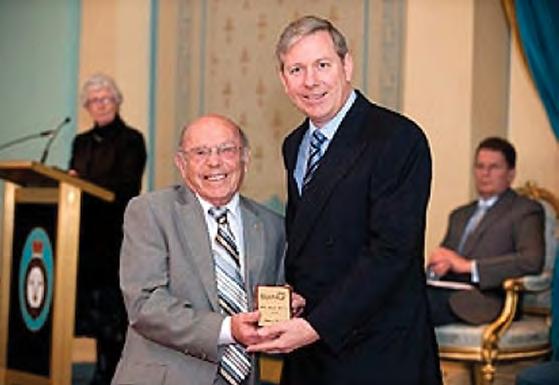
Willy Lermer and Fred Steiner have recently been honoured by the Jewish Community Council of Victoria (JCCV), and deservedly so, for the wonderful work that they do on behalf of the Centre and the Jewish community generally. Both Willy and Fred are Holocaust survivors and longtime volunteers at the Jewish Holocaust Centre. We congratulate Willy, who received his award for his work at the Centre, and Fred for his contribution to the work of the Zionist Council of Victoria.
In a congratulatory letter sent to Willy by David Southwick MP, State Member for Caulfield, Mr Southwick wrote: ‘Our society is dependent on the work and effort of volunteers across many different sectors and roles. As someone who has been involved in a number of charity and volunteer-based organisations, I know how important your contribution is to the community.’
Mazal tov Willy and Fred!
JHC Centre News 23
Phillip Maisel OAM (left) receives his award from the Hon David Davis MP
Willy Lermer and Fred Steiner receiving their JCCV awards from Chin Tan, Chair of the Victorian Multicultural Commission (Photos: Peter Haskin)
Singing for All He’s Worth
Published by Pan Macmillan 2011
Edited by Alex Skovron, Raimond Gaita and Alex Miller
Reviewed by Elaine Davidoff
In March 1948 Jacob Rosenberg – poet, award-winning author and spinner of wonderful tales – boarded a ship at Marseilles with his new bride Esther and sailed to Australia to begin life anew, away from the horrors and destruction of Europe. Both were survivors of the Holocaust; Jacob lost his entire immediate family including his parents, two sisters and two nieces, who perished in Auschwitz.
Rosenberg died in October 2008 after a period of remarkable creativity. Over about fifteen years he wrote three collections of poetry, a book of short stories, two prizewinning memoirs, East of Time (2005) and Sunset West (2007), which concern his life in the Lodz ghetto and the nightmare of the Holocaust, and a novel, The Hollow Tree
After Rosenberg’s death, his friend and colleague Raimond Gaita conceived the idea of editing a collection of essays written in Jacob Rosenberg’s honour. He approached Alex Skovron and Alex Miller to join him and they commissioned writers who had been inspired by Rosenberg and who admired his work. The result was Singing For All He’s Worth.
In his essay ‘Like a World in Itself’, Raimond Gaita writes of the German invasion of Rosenberg’s town. Rosenberg’s schooling ended then but ‘his education did not’. In his wonderful book of memoirs, East of Time, Rosenberg writes, ‘I lived in the heart … of a veritable bazaar of diverse people and ideas.’ His daughter, Marcia, in her deeply respectful and loving essay ‘Threads’, writes, ‘His thirst for learning was almost as acute as his will to live, and whenever the opportunity arose he sought out professors and scholars amongst the camps inmates, who in the dark corners of the barracks would … hold court.’
In his contribution ‘Ghetto Loves’, an informative and insightful tribute to Jacob Rosenberg, Arnold Zable writes, ‘Rosenberg was a prolific Yiddish writer long before he began writing in English … Mamesloschn was the language in which he first found his voice as a writer, and in which his response to the horrors he had survived first found expression.’ Both Danielle Charak and Zable write of Rosenberg’s profound love of his mother tongue and his despair at its possible demise. Rosenberg expresses this so heartbreakingly in the lines, ‘Yiddish, my beautiful mother tongue / how sad will the world be without you.’
The essays by Charak and Zable are essential reading if one hopes to gain some understanding of Rosenberg’s work as well as to appreciate the character of this remarkable man. Charak, in her essay ‘In a Corner of His Dreams’ writes,
‘Jacob’s language is at the very heart of his identity, of his Jewish identity – which is the essence of his identity as a human being.’
Moving from writing in Yiddish to English (his third language) did not, at least initially, come easily to Rosenberg. He had never been formally educated in English and his daughter Marcia fondly recalls ‘his obsession with overcoming difficulties in spelling, grammar and syntax.’ But, according to Zable, having expressed his pain and rage in his mother tongue, he was now ready as a mature artist to address a universal audience. After immigration, Rosenberg had needed to work, build a new life and care for his family, and it was only after retirement that he was finally free to pursue, unencumbered, his true passion.
The title of this book is taken from the last line of a tribute poem to Rosenberg, ‘Man Singing by Candlelight (after Adam de Coster)’ by Peter Steele. A Jesuit priest, academic and poet, Steele is one of many writers, poets, publishers and academics in the broader Australian literary world who came to know and in many cases love this man with his genial personality, sharp intelligence and twinkling eyes. What began as a professional relationship often became something more. As Morag Fraser writes in her essay ‘Life, People, Love and Hate’, ‘Perhaps it is that artist’s openness – so much in defiance of the odds and his history – that enabled Jacob to be such a generous companion to someone like me, a woman who shared neither his culture nor his experience.’ To Chris Wallace-Crabbe, ‘He remains in my mind as a loving, sceptical godfather. Not only was he devoted to his family, but he also offered love to those who became his friends.’
There were many influences in Rosenberg’s literary life, the earliest being his teachers at the Vladimir Medem school where his teachers ‘were mentors by day, librarians at dusk and camp-leaders during our holidays.’ In his warm and rich essay ‘Landscapes of Disenchantment and Hope’, Alex Skovron reveals the depth and breadth of Rosenberg’s reading: ‘Already as a boy he read widely … and throughout his life he remained a prodigious reader, forever open to discovery and delight, be it fiction, philosophy, history, biography, the essayists, the magic realists, the classics and contemporary poets.’ But in addition, ‘Jacob – the secular agnostic believer – returned almost daily to his beloved Bible and frequently to Shakespeare: these he regarded as the twin pillars of Western literature.’
Other authors of note who write with admiration and warmth about Jacob Rosenberg include Alex Miller, Helen Garner, Geoff Page and Richard Freadman. Each piece reveals something different about a man whom they all came to respect and in some cases revere. The essays tell us much about Jacob’s personal, literary, religious and even political views.
Singing For All He’s Worth is a wide-ranging and enriching anthology which should send you hurrying to read the work of this wise, witty and profoundly humane writer.
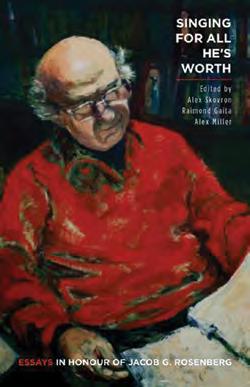
JHC Centre News 24
BOOK REVIEWS
The Bibliography of Australasian Judaica 1788–1008
Third Edition, published by Hybrid Publishers 2011
Compiled by Serge Liberman
Reviewed by Bernard Korbman OAM
When I was asked to write a review of Serge Liberman’s The Bibliography of Australasian Judaica 1788–2008, I approached the task with a great deal of trepidation. I had in the past reviewed Dr Liberman’s book Where I Stand and found it to be a profound and moving collection of short stories. However, I had never reviewed a bibliography before and was quite daunted by the prospect of doing so.
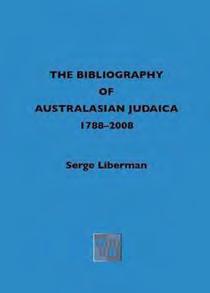
To do justice to the author and to you, the readers of Centre News, I opened page 1 and began to read. It did not take long until I was hooked. It was just like ‘surfing the net’, only everything related to the subject matter was contained right there, in my hands. I discovered a hidden cache of Jewish treasures, a repository of knowledge which when assembled together gives the most awesome portrayal of resilient, vibrant and creative Jewish communities throughout Australia and New Zealand.
The book is divided into a number of specialised categories. Part One is dedicated to fiction and is further divided into three major themes: ‘Creative writing by Jews in English and European languages’; ‘Creative writing by Jews in Yiddish and Hebrew’; and ‘The Jew as character in host Australian literature’.
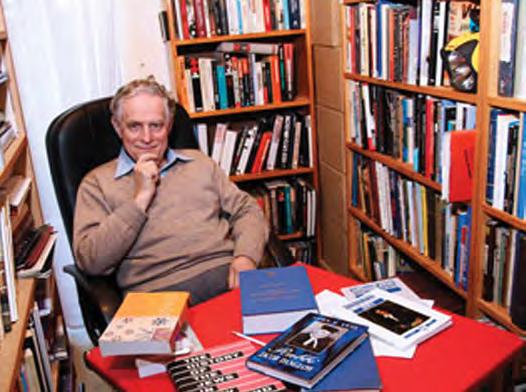
Part Two, sections 4–13, covers non-fiction and is truly a treasure trove of two hundred and twenty years of social, cultural, political, artistic and religious endeavours by Jews in Australasia. This section captures the dynamism of Jewish life since settlement in 1788 and, through its content, gives an historical insight into the development of our current communal identity.
The introductory chapter in the non-fiction category is a collection of essays that include discussion papers, seminars and other works dealing with such wide-ranging issues as inter-faith dialogue, antisemitism and Holocaust survivor experiences in Australia, to communal debates regarding the role of Jewish institutions, welfare and philanthropy as well as eulogies and commentaries of Australasian Jewish dignitaries.
A thorough coverage is given to the arts and other important cultural and communal activities. Art, architecture, photography, literature, music, dance,
theatre, film and media are covered comprehensively. Sport and Jewish cuisine are also included.
Chapters referring to language and education, autobiography and biography, genealogy, demography, the history of Jews in Australasia and Jewish visitors to Australia form a large part of the non-fiction category.
‘Politics, World Wars I and II, Zionism and memoirs’ gives the user of this bibliography the ability to source material which covers the Jewish Australian perspective on the wars, the Holocaust and Zionism. It also covers the perspective of Jews now making their homes in Australasia who actually took part, either willingly or not, in these historical events.
Because of my bias and interests, I found the section on ‘Judaism and Philosophy’ of particular interest and I must admit already trying to find some of the resource material quoted in this chapter.
Part Three reveals the sources for the bibliography and contains a subject and names index.
This bibliography is a testimony to Dr Liberman’s scholarship, and to his inquiring and inquisitive mind. Every major cultural institution in Australasia should have this bibliography as part of its reference collection. Every Jewish institution in Australasia should make good use of this publication, as I believe not enough people in our community, let alone the general population, know enough about Australian history and the part that Jews have played in it since European settlement.
Above all, I believe that Jewish day schools would benefit from using The Bibliography of Australasian Judaica 1788–2008 to help develop a deeper understanding and appreciation of Australian history and Jewish history in Australia. Hopefully, this knowledge and appreciation of the contribution of Jews who have helped to fashion the kind of society in which we live today will encourage the younger generation to continue the Jewish tradition of participating in all forms communal and societal endeavours.
Dr Liberman has done a great service to the Australian and New Zealand community as his bibliography takes its place among the reference works, capturing the essence of the Jewish contribution to both countries’ history and identity.
JHC Centre News 25
Originally established five years ago as a group for retired guides and volunteers of the Jewish Holocaust Centre (JHC), the JHC Social Club has now broadened to become an inclusive social group for all guides and volunteers, as well as retirees. Whilst providing the opportunity for social interaction, it now also acts as a forum for professional development in a relaxed and informal atmosphere.
We ended 2011 with a number of stimulating speakers who covered a wide range of topics. Peter Alexander, Australia’s ‘pyjama king’ told his fascinating story. Beginning by making pyjamas on his mother’s living room table, he now runs an internationally recognised sleepwear business and brand name. Ruth Scheuer spoke of her life as a child in hiding during the Second World War, as well as her passion and tireless work for Israel. She has been a WIZO worker for over 53 years and has helped to raise millions of dollars for WIZO’s children’s home in Israel. Dr Dvir Abromovich, Jan Randa Senior Lecturer in Hebrew-Jewish Studies and Director of the University of Melbourne Centre for Jewish History and Culture, gave a fascinating analysis of the Israeli-Palestinian conflict. Other speakers included Anna Epstein, the curator of the exhibition Mameloshn: How Yiddish made a home in Melbourne, who spoke about the exhibition and related it to her own history and her evolving love for the Yiddish language. Professor Leah Garrett, Monash University School of Philosophical, Historical and International Studies, discussed her recently published book A Knight at the Opera: Heine, Wagner, Herzl, Peretz and the Legacy of Der Tannhauser, which examines the role that the medieval
JHC Social Club
Barbara Sacks
Tannhauser legend and Wagner’s opera Tannhauser played in Jewish cultural life in the nineteenth and early twentieth centuries.
We ended 2011 on a high with lunch at Ricketts Point. It was a perfect day with clear skies, good food and great fun.
The JHC Social Club meets fortnightly on Thursdays in the Marejn Auditorium of the Jewish Holocaust Centre. A light lunch is served and transport is provided for anyone who needs it. Run by Barbara Sacks and Max Wald, we have an exciting list of speakers lined up for the year. If you wish to attend, please contact Tosca at the Centre on 9528 1985. For further information about the Club, phone Barbara on 9596 9857 or Max on 9676 2975. We look forward to seeing you there!

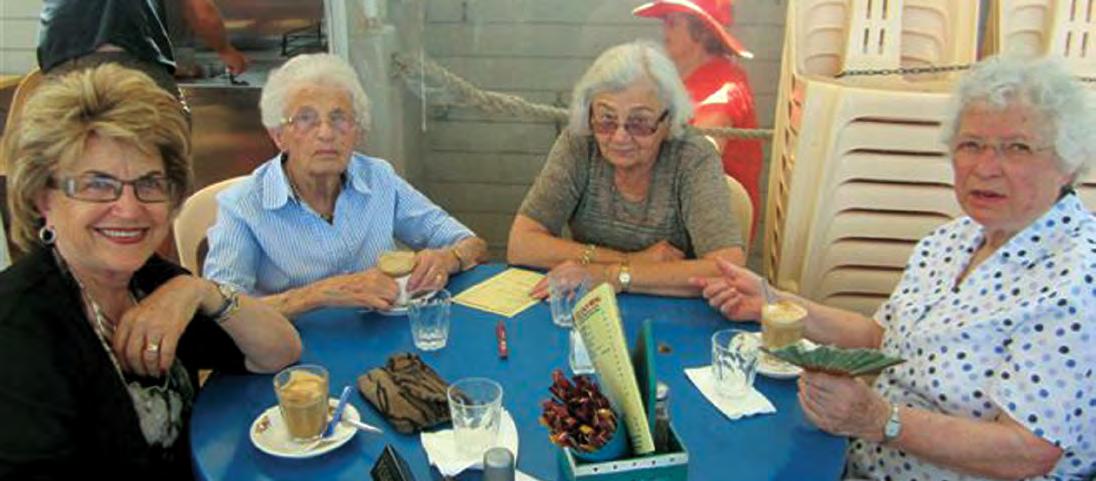
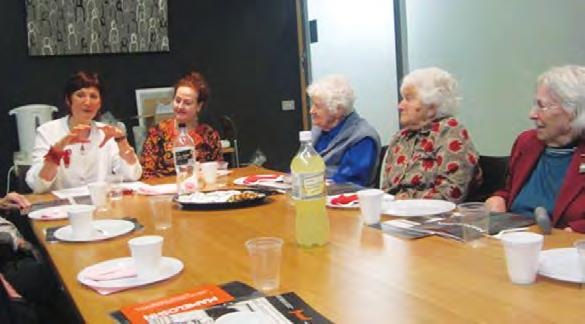
JHC Centre News 26
Anna Epstein addressing the JHC Social Club
(l-r) Barbara Sacks, Eva Somogyi, Clara Weiss and Saba Feniger
(l-r) Lulek Bron, Sonia Weisenberg and Pesia Helfenbaum
Growing up in Elwood in the 1960s I took it for granted that most of my parents’ friends had numbers tattooed on their arms, spoke Yiddish, and were at their happiest listening to Yiddish records, eating, drinking a schnapps or dancing at a simcha. Most did not speak about their past, but toiled in the present and got on with providing for their future. I was aware that I did not have grandparents, let alone aunts, uncles or cousins.
After university, work, marriage and a family, I settled into volunteer community involvements. My strong Jewish heritage and love of history drew me to guiding at the Jewish Holocaust Centre. Later, I joined the Friends committee, capably led by Elly Brooks. At the end of last year I was delighted to be invited to become the president, with Elly as co-president.
Last October we held ‘Songs in the Key of Life’, a concert at the Glen Eira Town Hall. In December, we helped out with the Centre’s end-of-year lunch, which was extremely well attended by staff, guides, volunteers and board members.
To inaugurate the new year, we held a brainstorming Sunday brunch meeting, where members came brimming with exciting ideas. We sincerely appreciate the dedicated efforts of Friends who are leaving our committee and look forward to new faces coming on board.
In February we held a successful film night at the Classic Cinema, where we previewed the award-winning Israeli movie Footnote. We look forward to a continuing association with the Classic and appreciate their support. We plan to hold a series of drawing room meetings to introduce people to the Centre and the upgraded museum. If you do not have time to join our committee, please
Friends of the Jewish Holocaust Centre
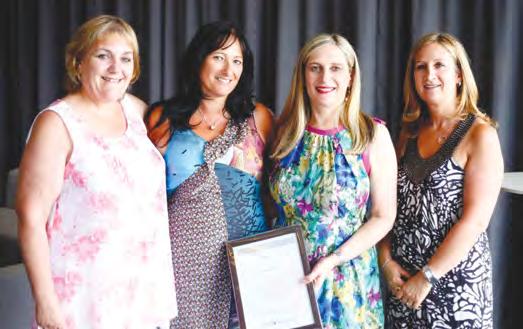
Goldie Birch
consider becoming a Friend by filling out the membership application below and coming to our functions.
To celebrate the milestone of my 50 th birthday in January, I hosted friends and family to a luncheon and in lieu of gifts requested donations to the Friends of the Jewish Holocaust Centre. If you are having a simcha or commemoration, I encourage you to consider the Centre. For further information about the Friends committee and functions, please phone me on 0407 560 515. Chag sameach!
Help support the activities of the Centre by becoming a Friend
JHC Centre News 27
F RIENDS OF THE J EWISH H O l OCA u ST C ENTRE M EMBERSHIP A PP l ICATION F ORM (2011—2012) Title _____ First Name ________________________________ Surname ______________________________________________ Address ____________________________________________________________________________________ postcode __________ Daytime Contact Number __________________________ Mobile __________________________ E-mail ___________________________________________ Cheque payable to: Friends
Credit Card: Visa
Amex Card No: Expiry Date: ________ /________ Cardholder Name: _________________________________________________________ Signature: ________________________________________________________________ $25 Single $45 Family $15 Single Concession $ ________________ Tick here for Young Friends (under 35) $ ________________ DONATION (All donations over $2 are tax deductible) $ ________________ TOTAl AMOuNT $ ________________ Please send payment to: Friends of the Jewish Holocaust Centre 13-15 Selwyn Street, Elsternwick 3185 Telephone: 9528 1985 Fax: 9528 3758 Email: friends@jhc.org.au Website: www.jhc.org.au PAYMENT DETAIlS FRIENDS ANNuAl MEMBERSHIP FRIENDS
Friends of the Jewish Holocaust Centre
of the Jewish Holocaust Centre
Mastercard Diners
(l-r) Alice Peer, Sue Lewis, Goldie Birch and Rosie Meltzer at Goldie’s 50th birthday where she asked guests to donate to the Friends of the Jewish Holocaust Centre in lieu of gifts
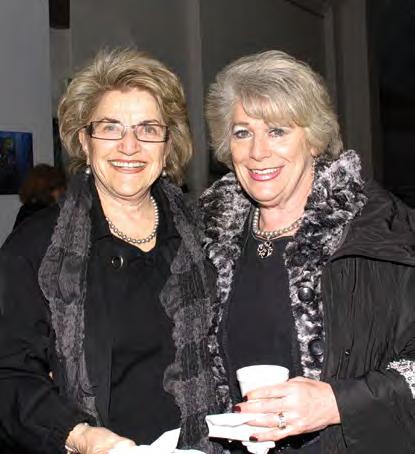
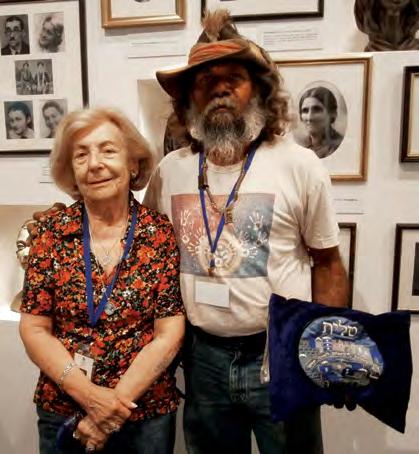

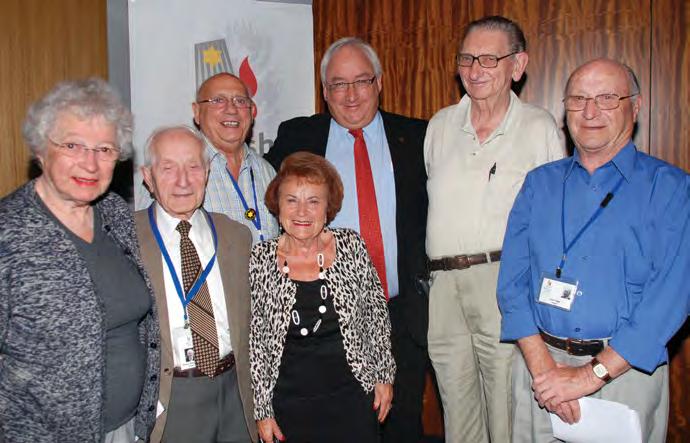
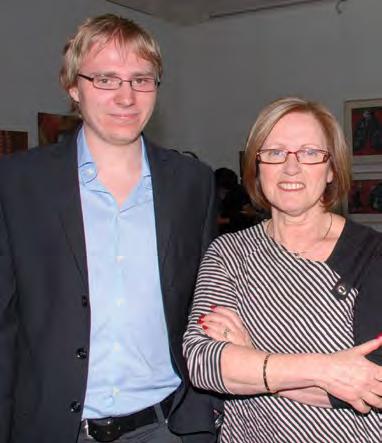
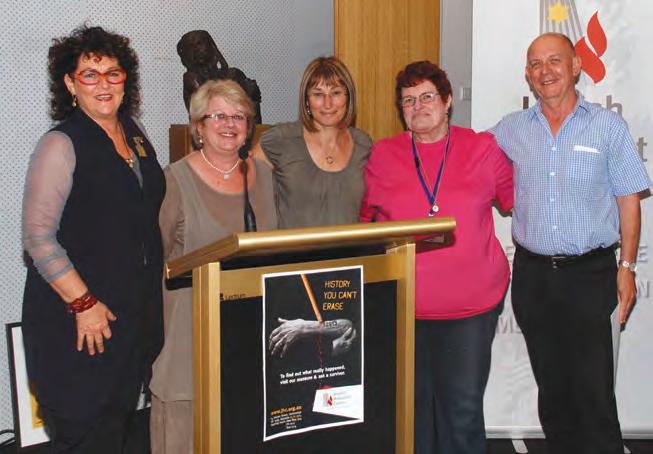
SEEN AROUND THE CENTRE 28 JHC Centre News
(l-r) Barbara Sacks and Lyn Samuel at ‘The Many Faces of Eve’
Lusia Haberfeld and Brendon Cook at the museum
(l-r) Helen Mahemoff, Adam Kreuzer and Jeffery Mahemoff AO at the UN Holocaust Memorial Day commemoration
(l-r) Saba Feniger, Abram Goldberg, Tuvia Lipson, Cesia Goldberg, The Hon Michael Danby MP, Fred Steiner and Jack Fogel at the JHC Social Club
Sebastian Hausleitner and Silvana Layton at ‘The Many Faces of Eve’
(l-r) Pauline Rockman OAM and Miriam Weiss with Mali Kohn Award recipients Gita Ginger, Ziva Fain and Jack Ginger
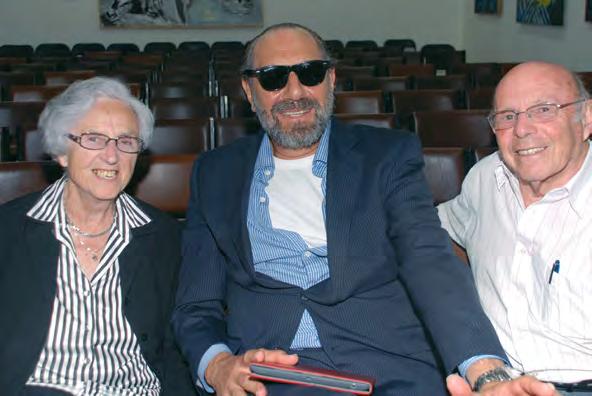



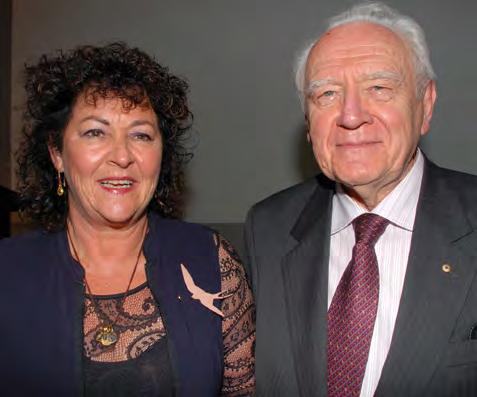

JHC Centre News 29
(l-r) Rose Freilich, Sandy Gutman aka Austen Tayshus and Phillip Maisel OAM at ‘In Coversation with Elliot Perlman’
(l-r) Moshe, Franka and Lena Fiszman at Moshe’s 90th birthday celebration
(l-r) Andrew Rogers and Reuben Zylberszpic at ‘Sculpture & Memory’
(l-r) Evelyn Krape and Tomi Kalinski at ‘The Many Faces of Eve’
Pauline Rockman OAM and Christopher Lancucki AM at the UN Holocaust Memorial Day commemoration
(l-r) Jewish Holocaust Centre staff Zvi Civins, Jayne Josem, Tosca Birnbaum, Michael Cohen, Claude Fromm, Lena Fiszman, Daniel Feldman, Phillip Maisel OAM and Warren Fineberg
‘This is a true story, a year of horrors’
Jayne Josem
A small unpublished manuscript in the Jewish Holocaust Centre collection begins with the words, ‘I don’t intend to make a masterpiece’, yet Susan Hersch’s typed memoir tells one of the most absorbing stories you could ever read.
Susan first learned of antisemitism at school in Szeged, Hungary, when her brother was badly beaten up after a schoolmate said: ‘You have a very pretty sister; what a pity she is Jewish!’ She later witnessed many ‘Jew-beatings’ from the window of the family apartment and describes the bullies as being ‘intoxicated with joy’. She also recalls the family’s incredulity when hearing the stories of brutality told by Polish Jewish refugees.
Susan’s family had an opportunity to hide, but they refused, as it would have meant separating. As her father became increasingly concerned, he organised papers to prove the family had converted to Christianity many years earlier. Her brother Tomi was called up for Forced Labour Service and sent to work in terrible conditions in the copper mines in Bor, Yugoslavia. The prisoners were starved and tortured, and in September 1944 the SS forced them to dig their own graves and shot nearly all of them.
The Jews of Szeged were moved into a ghetto and then to a brick factory. In June 1944 they were sent to the railway station and ‘loaded like cattle in the freight cars so tight we couldn’t sit properly and could hardly breathe. Two or three days later, with hermetically closed doors, with dead people, unbearable smell (no facilities), no food or water,
Susan describes the horrific conditions in Auschwitz in great detail. ‘The whole lager looked grey; not a tree or grass, even our dirty rags had the same colour. I don’t remember if we had one single day of sunshine; it seemed that the sun also vanished with everything else considered normal.’
Prisoners slept crammed together on the floor with no blankets. Susan describes the daily routine of roll calls, some in the middle of the night. The prisoners were called ‘Schweinerei’ (filth) and were whipped and beaten. The meagre rations came in dirty pots – disgusting, grey soup made with water and a few turnips. She forced down six spoonfuls because her mother insisted she needed it to survive. There were daily ‘selections’ where prisoners had to stand naked, in rows, with arms uplifted before the ‘Angel of Death’, Dr Mengele. The women stayed close together in order not to appear too skinny.
we arrived in Auschwitz.’ The selection process happened quickly. The prisoners – including Susan and her mother –were then disinfected in a shower, shaved and given some rags to wear and, if lucky, shoes. Susan writes: ‘In short the sequence was: from home to ghetto we were allowed to take some furniture, clothing and minimal necessities. From ghetto to brick factory only a haversack with some clothing. In Auschwitz, no more haversack, and finally, after “admission”, no more anything.’
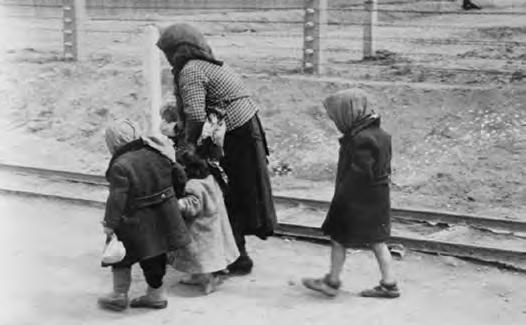
At the first roll call the Slovakian Jewish kapo (leader) pointed to the crematorium chimneys and told them that their families were about to be gassed and cremated.
One day, during a selection, Susan was separated from her mother. The following day Susan was selected and taken with a few hundred women to the crematorium. She surmised that her mother had been murdered the previous day. She goes on to describe the scene: ‘The crematorium complex consisted of an ante room where the victims had to undress before being forced into the so-called shower room (complete with dummy shower roses), which was in fact the gas chamber. The heavy iron doors were closed hermetically on us. We just stood there naked, very closely pressed to each other. By then we knew all about their methods, they couldn’t mislead us anymore. We had to be there for approximately 10 minutes before the Zyklon B crystals were to be dropped from a trapdoor in the ceiling. (The waiting time was necessary for the bodies to warm up the air as Zyklon crystals transform more effectively into gas at a certain temperature.) Everything went “smoothly” and we were aware of the fact that these were our last minutes of life. We were calm, no reaction, no fear of death, no anger, a total lethargy took over. Life rejected us.’
Then a miracle occurred. The doors opened and some of the women closer to the door, including Susan, were taken out of the gas chamber. They were taken to a real shower, given striped uniforms, shoes and scarves, and then taken to the railway station. The Krupp Aircraft factory urgently needed workers so they were taken to Sachsenhausen camp, where they had bunks, a blanket and even a cupboard (although nothing to put in it!) Every morning they were marched to
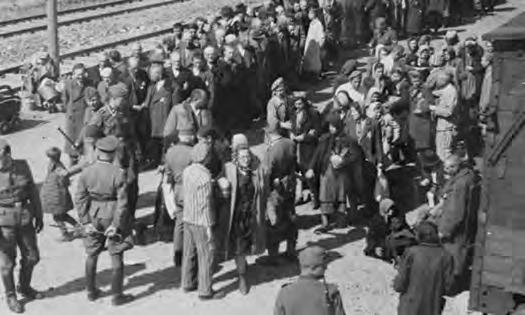 A Jewish woman walks towards the gas chambers with three young children, May 1944. Photographer: Bernhardt Walter/Ernst Hofmann.
Source: US Holocaust Memorial Museum, courtesy of Yad Vashem
A Jewish woman walks towards the gas chambers with three young children, May 1944. Photographer: Bernhardt Walter/Ernst Hofmann.
Source: US Holocaust Memorial Museum, courtesy of Yad Vashem
30 JHC Centre News STORIES FROM THE COLLECTION
Hungarian Jews arriving on the platform at Auschwitz in 1944 undergo the selection process, where they are selected for either hard labour or death.
Source: US Holocaust Memorial Museum, courtesy of Yad Vashem
the Krupp Aircraft factory and every evening they were marched back. The food was still insufficient, but it was slightly better. Their spirits gradually lifted and their will to live returned.
When Susan was visibly distressed one morning, the foreman asked her what was wrong. She explained that it was her birthday and she missed celebrating it with her family. After lunch the foreman called her over to a corner, out of view, where he had made a ‘party’ for her: a pink drink and a slice of cake.
After she hurt her back from lifting a heavy box in the factory, she was sent to the sick bay. Susan soon forgot the pain and felt happiness as she lay in bed between white sheets, in a heated room with music playing. On her way out, however, she glanced in the mirror and was terrified to see what had become of her.
One day, the inmates were suddenly taken from the camp to begin a long march. The journey took over a week and anyone not strong enough to keep moving was shot and left to die by the roadside. The women helped each other to keep going, not to give up. When Susan felt she had had enough, a friend slapped her in the face, jolting her senses and giving her the courage to continue. Corpses lay by the side of the road but they carried on ‘like sleepwalkers’. They had no food for five days. Suddenly they found themselves trapped in a forest between two enemies, giving them hope that the end of the war was near. On the sixth day they reached a camp for French political prisoners who offered them their daily ration – ‘a terrific meal!’ Soon after, a Red Cross van approached and gave each prisoner a box filled with delicacies, including chocolate biscuits and sweet condensed milk. Now that they had some food, she and her friends decided to escape, as their guards were intending to kill them rather than hand them over to the enemy. They fled and found refuge in a farmhouse stable, along with about thirty others. Then the Russian liberating army arrived.
The girls began their journey back home, worried about what they would find. Susan was happy to be alive but uncertain of the future. The friends met three Hungarian boys and together they entered an abandoned German villa and helped themselves to clothes, makeup and perfume, and brushed their teeth. They kept travelling and were fortunate to be in a group because Russian soldiers constantly tried to be intimate with them. It took them three months to reach the Hungarian border.
When Susan arrived home she had to face the reality that she was the only survivor from her family. Arriving at the station she saw one of her father’s friends who did not recognise her at first as she weighed 33kg and only had one inch of hair. The authorities allowed Jews to go back into the ghetto to search for their belongings. The only possession Susan took was the prayer book which had been passed down from her grandmother to her mother.
Susan moved in with family friends but life was a real struggle. Eventually she married, gave birth to a baby daughter and started to learn to love again. The family decided to leave Hungary illegally but were captured in Slovakia and sent to an internment camp in Hungary where precious photos of Susan’s mother were confiscated.
Susan’s first husband died in 1953, so her struggles began afresh. In 1956, with Hungary in turmoil, she migrated to Australia with her young child, her brother-in-law and his family. Three years later she remarried and began a new chapter in her life. That is where her manuscript ends.
New acqisitions
Claude Fromm
The following are additions to the Centre’s collection from September to December 2011:
1. Original front page of Der Stürmer newspaper Number 13, 1939.
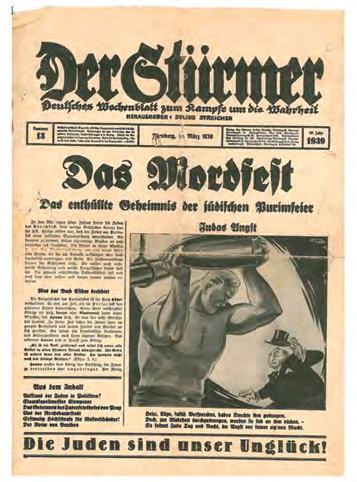
Donor: Rabbi Jekuthiel Broh
2. Book in Polish by Leon Held, together with photocopies and original documentation relating to the donor’s family, including birth and death certificates, passports and location certificates.
Donor: Samuel Langer
3. Book titled The Exchange: Inferno to Paradise by Klaus Hillenbrand, translated by Ian Korman.
Donor: Ian Korman
4. Drawing of Auschwitz titled ‘Hope’ by Kevin Maxwell.
Donor: Kevin Maxwell
5. Booklet of sketches of the Holocaust titled 1944 by Peter Aldor
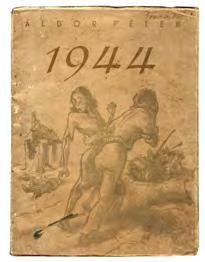
Donor: Anonymous
The Jewish Holocaust Centre (JHC) collection is a vital repository of Holocaust-era material. Artefacts and documents are carefully catalogued and stored in a stateof-the-art temperature-controlled facility to ensure their preservation for future generations. The JHC invites members of the public who have precious items relating to the Holocaust to consider donating them to our collection for safekeeping.
JHC Centre News 31
COLLECTIONS
Front page of Der Stürmer
Cover of sketch book by Peter Aldor
Twins celebrate their bar mitzvah by giving to the Jewish Holocaust Centre
When twins Joshua and Elliot, sons of Aviva and Henry Debinski, celebrated their bar mitzvah in August last year they followed in the family tradition of giving to charity when celebrating a simcha. Joshua and Elliot asked their guests to donate to the Jewish Holocaust Centre and Yad Sarah in Israel in lieu of gifts.

Joshua and Elliot’s paternal grandfather, Marek Debinski, and their maternal grandmother, Eva Slonim, are both Holocaust survivors. After the Second World War Marek was the sole survivor of his large family. Eva was thirteen years old when she and her younger sister, Marta, then aged ten, were arrested by the Gestapo and transported to Auschwitz. On their arrival at Auschwitz, Eva and Marta were selected for medical experiments by ‘Angel of Death’
Dr Josef Mengele, who mistook them for twins. Joshua and Elliot have spent hours with Eva, talking with her about her experiences during the war. Her stories are not only special to them because she is their grandmother, but also because they are twins.
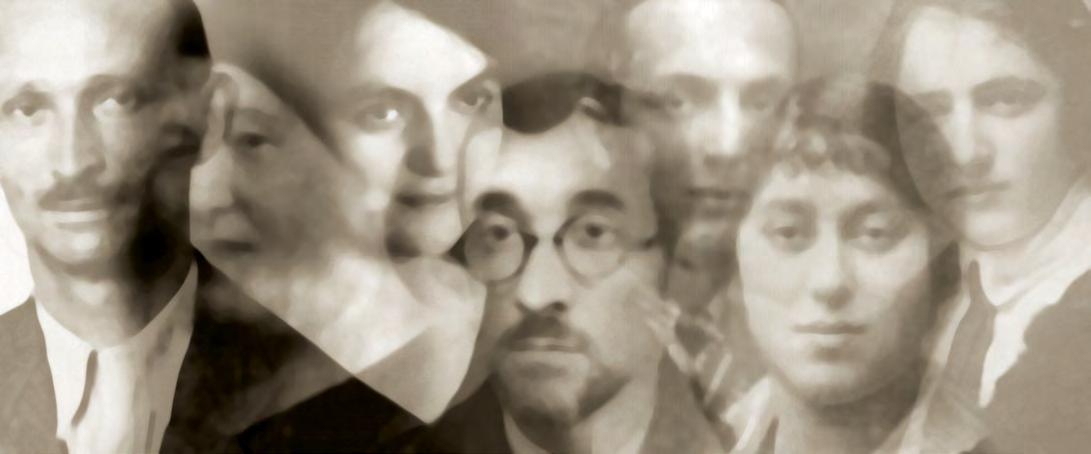
As their beloved uncle Malcolm Slonim passed away in 2008, Joshua and Elliot asked that the money raised at their simcha be given to the Centre in his memory.
The Jewish Holocaust Centre greatly appreciates Joshua and Elliot’s generous donation. If you are interested in finding out more about requesting a donation to the Centre in lieu of gifts, please contact Reuben Zylberszpic, Development Officer, on (03) 9598 1985.
JHC Centre News 32
Don’t miss the chance to become a Partner in Remembrance through the Jewish Holocaust Centre Foundation to ensure the ongoing success of JHC. Three levels are available, payable over five years. All donations are fully tax deductible Gold Partner $18,000 Silver Partner $10,000 Bronze Partner $5,000 Each ‘Partner in Remembrance’ will be acknowledged. Further details are available from Helen Mahemoff, Chair of the Foundation t: 9822 8080 or 0417 323 595
(front, l-r) Elliot and Joshua Debinski with their family, (l-r) Carly and Motti Bloom, Henry, Aviva, Abbie and Gabrielle Debinski and Ben and Eva Slonim
Celebrating Kitia Altman and Sabina Josem

In March the Jewish Holocaust Centre (JHC) held a joyous celebration to mark Kitia Altman’s ‘special’ birthday and Sabina Josem’s ‘almost special’ birthday. Both Kitia and Sabina are Holocaust survivors and long-time volunteers at the Centre, Kitia as a guide and Sabina as one of the Centre’s two librarians. Elly Brooks, representing the JHC President and Board, presented Kitia and Sabina with certificates of appreciation in their honour. A special moment occurred at the end of the proceedings when Patricia Hammond from Mooroolbark College presented flowers to Kitia on behalf of the students in her school in recognition of Kitia’s contribution to their history program.
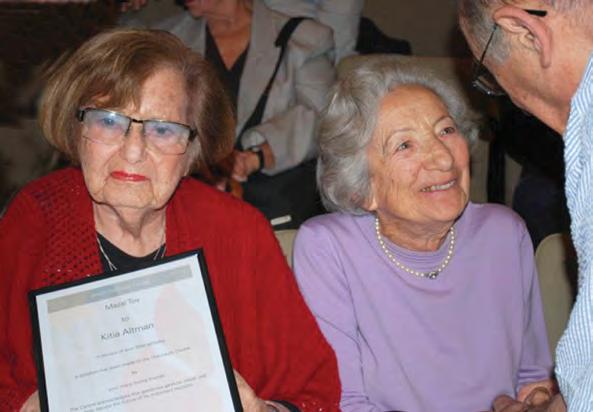


JHC Centre News 33
(l-r) Abe Goldberg, Kitia Altman, Sabina Josem and Moshe Fiszman
(l-r) Helen Leperere and Kitia Altman
(l-r) Kitia Altman and Sabina Josem
Pearl Recht 2 January 1921–25 August 2011
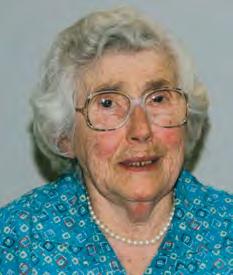 Eve Recht
Eve Recht
How do you summarise a life? How do you compress 90 years, three continents, one Holocaust, three children and several careers into one page? Never mind adding salt and pepper, a little flavour …
Perhaps if I omit the niceties, the linking of paragraphs and dates, then I can tell you about Pearl Recht, my mother.
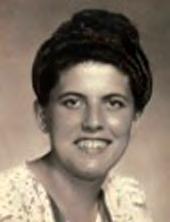
Born in Warsaw, to Chava and Aaron Domb, the fifth of seven children. The family was poor, but there was always someone in greater need, like the country in-law who had no other home, or the classmates for whom Pearl organised the collection of matzot and eggs before Pesach
left school at 14 to help the family finances, working with her beloved eldest sister Fay, who had opened her own small hairdressing salon, with the significant financial help of Gentile friends. (How to make Pearl angry: proclaim that all the Poles were antisemitic.)
Escaped east from Warsaw soon after the Nazi occupation, with her then-boyfriend Jacob Recht. By train and on foot to Bialystok, then trudging through freezing snow to smuggle across the border into Lithuania, ironically succeeding through an amnesty declared for Stalin’s name day. (Jacob was hiding from Stalin’s henchmen; he was a reasonably well-known Trotskyite.)
Spent two winters in Vilna, trying to get entry visas to America, England, anywhere safe …
Managed, eventually, to obtain a forged Sugihara transit visa for Japan, and a landing permit for the Dutch colony of Curacao. (Imagine if they had really gone there!) With a kosher ticket for the Trans Siberian Railway (paid for by the JOINT – the American Jewish Joint Distribution Committee) but without a Russian transit visa, made it right across Eurasia to Vladivostok …
But Japan was no longer accepting refugees, with or without the right papers. So again, telegrammed around the world for help … No one opened the door, but Shanghai was suggested.
Five days on the boat to Shanghai stank – of the fish that was its usual cargo – and Shanghai itself was no picnic, but they managed. As elsewhere, there were committees, lists, resilience, community, and many random acts of kindness. Saw out the war in Shanghai, and remained there until December 1946.
Arrived in Melbourne in February 1947 with baby Alex, hardly any possessions, and gratitude towards Arthur Calwell, Australia’s Minister for Immigration.
Accommodated temporarily in Burwood, but felt so at home they stayed for twenty years in that suburban openness. Two more children and an embroidery business begun there.
Pauline Exclusive Embroidery, named after Pearl, and housed in Flinders Street, was highly successful in the 1950s and 1960s. Jacob embroidered, designed, and schmoozed clients; Pearl organised, filled gaps, created systems and solved problems.
Changed careers, opened a top-class cake shop in the early 1970s: luscious cakes and biscuits but incredibly hard work. Found a more challenging and rewarding niche in the mid-1970s: employed as a relieving house mother with Melbourne Family Care, a group of family-based fostercare homes. Gave groups of kids wonderful school holiday experiences at the organisation’s bayside holiday home.
Moved to Jewish Welfare, as first supervisor of Glen Eira House, a residential home for young adults with disabilities. For several years supported and empowered the residents, as well as running an efficient and pleasant household. Retired at age 65, in 1986. Widowed later that same year. Began her ‘retirement’ by energetically attending several long-running U3A groups in Hawthorn. Studied public speaking, current affairs, the works of Carl Jung. U3A nourished and challenged Pearl, who brilliantly exemplified ‘life-long learning’, well before that term became fashionable. Joined the Jewish Holocaust Centre as a volunteer guide in 1987. Every Tuesday, stood at ‘the map’ – a large wall map of World War Two Europe – to teach students about the Holocaust, and also gradually to tell more of her own story to students and teachers who were riveted by her powerful storytelling.
Remained resourceful and determined, curious and committed to those around her, through increasing frailty, a broken leg, failing eyesight, and generally getting older. The end was sad, but quick. I know she would not have wanted to die in a house fire, but I also know she did not want to fade away gradually, losing her intelligence or her physical abilities, or both. And the week that she did survive after the fire was a blessing for us all: she died quietly and calmly, with her family around her. And her legacy? Three children, Alex, Eve and David, and two grandchildren, Noah and Aaron. Thousands of students with greater understanding and knowledge. Many stories still unfolding. And for those in the know, an unforgettable apple cake.
JHC Centre News 34
OBITUARIES
Pearl Recht, 1941
Pearl Recht, 2008
In memory of Abe Frankel
Pauline Rockman OAM
Abe Frankel was born in Piotrkow, Poland, the first Jewish male child born there after the Holocaust. He arrived in Melbourne with his parents, sister and brother in 1947, settling in Melbourne.
Abe, like me, was a ‘baby boomer’ – part of the post-war generation, moving on and leaving the shadow of war behind. However, the war was ever-present, a huge dark cloud hovering above us but not quite visible. As we were growing up we overheard talk about gas chambers, concentration camps and death. It was not an uncommon sight to see people with numbers tattooed on their arms and to be aware on some level about this thing known as the Holocaust. However, in those days there were no counselling services – just the realisation that the survivors had to get on with the business of recreating life, learning a new language, creating a new family and adapting to life in a new country.
And what of the second generation? Eli Wiesel says: ‘Their role in a way is even more difficult than ours. They are responsible for a world that they did not create. Those who did not go through the experience must transmit it.’ This is the context in which Abe and I met as teenagers. He was the cool dude, intelligent, but at a distance, opinionated to a degree, but with awareness and a very
keen and analytical mind. Friends say he was a true child of the 60s. One recalled what a great dancer he had been (even winning a twist competition.)
Abe and I saw each other a few times in the late 1980s when our children Jordy and Ben were in the same class at school. Then, when I moved to Elwood ten years ago, we saw more of each other. I would see him playing chess in the St Kilda Botanical Gardens and we would have coffee in Carlisle Street, where we had heated discussions about our respective journeys to Poland. Currently his daughter Mali and my daughter Tahli study together.
Abe came to the Jewish Holocaust Centre four years ago, and it is where I believe he found his place. He initially found being at the Centre confronting and an enormous challenge, but he became very much part of the Centre family, and a member of the Friday group of volunteer guides.
Abe did not talk about being the child of survivors. Although there were many children of survivors in Melbourne, was it just too close a subject? Or was it ‘not on’ in this sunburned country where we wanted to get on and not feel apart?
Dear Abe, you are missed at the Centre. You brought to your guiding a sense of what we will experience in the future, the important and most essential role of the second generation and all future generations in maintaining and perpetuating the legacy of the survivors. We mourn your loss, but your spirit continues.
Pauline Rockman OAM is President of the Jewish Holocaust Centre. This is an edited version of her address at a commemoration at the Centre in September 2011 in honour of Abe Frankel.
Ignace Ross: rebuilding a life
Ignace (Izio) Ross was born in Krakow, Poland. He survived in AuschwitzBirkenau for 14 months before being transferred to Buchenwald and from there to Sachsenhausen. In April 1945 he was part of the ‘death march’ from Sachsenhausen. One month later, while still on the death march, he was liberated by Soviet Armed Forces near the town of Schwerin.
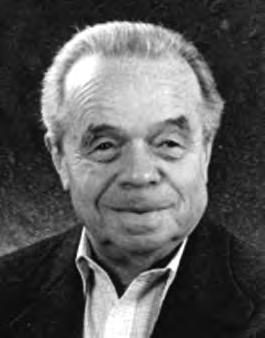

In Ignace’s own words: ‘My most remarkable feeling after liberation was an
unbelievable relief, that although Hitler decided that we Jews are not human beings and that our race must be annihilated, we did survive him and his henchmen, and are alive and free. No one could harm us. However, after finding out that no one from my immediate family –parents, siblings, aunties, uncles and cousins – are alive, that considerably dampened my ecstasy. I had survived three concentration camps and somehow I had to rebuild my life.’
Ignace did rebuild his life in Australia after the war, working hard and providing for his family. After he retired he became a volunteer at the Jewish Holocaust Centre. He had very able hands and undertook the many maintenance jobs that were needed – repairing things, putting up plaques and helping with the exhibits. He will be greatly missed.
JHC Centre News 35
Abe Frankel
Ignace Ross
Engagement
To Simon Michalowicz on the engagement of his grandson Joel Wermut to Sarit Meltzer
To Les and Kathy Janovic on the engagement of their son David to Rani Olstein
Wedding
To Ron Rushiniak and Natalie Jabolinski
To Pearl and John Buchanek on the marriage of their son Daniel to Michelle Abromwich
To Sarah Saaroni on the marriage of her grandson Alain Saaroni to Hana Vieva
To Ann and Yehuda Kabillo on the marriage of their son Boaz to Deborah Itzkowic
Wedding Anniversary
To Asya and Wolf Deane on their 50th wedding anniversary
To Barbara and Harold Sacks on their 50th wedding anniversary
Bar Mitzvah
To Victor and Marion Majzner on the bar mitzvah of their grandson Ben Ginsburg
To Henri and Sandra Korn on the bar mitzvah of their grandson Nicholas Serry
Condolences
To David and Ella Prince on the death of their brother and brother-in-law Henryk Prinz
To Ralph and Anna Glezer on the death of their father and father-in-law Leon Glezer
To Hannah and Mark Fagenblatt on the death of their mother and mother-in-law Trudy Borsky
To Ben Frankel and Mali Corinaldi on the death of their father Abe Frankel
Births
To Max and Pebby Wald on the birth of their granddaughter Mala Wald
To Elly Brooks and Allan Reid on the birth of their grandson Matcham Peirce
To Adam and Kim Kreuzer on the birth of their son Judah
To Mary and Peter Stawski on the birth of their grandson Joshua Charles Stawski
To Bronia and John Witorz on the birth of their grandson Tyson Cecil Crespin
To Tuvia Lipson on the birth of his great-grandson Luke Raleigh
Birthdays
To Goldie Birch on her 50th birthday
To Zvi Civins on his 60th birthday
To Henry Buch on his 70th birthday
To Barbara Sacks on her 70th birthday
To Claude Fromm on his 70th birthday
To Moshe Fiszman on his 90th birthday
To Kitia Altman on her special birthday
To Fred and Mariette Steiner on the death of their daughter Anita Steiner
To Sheila and Ron Leigh on the death of their step-father Pinkus (Pinche) Wiener
APOLOGY
In the last edition of Centre News the condolence notice for Rysia Burston referred to Lyla Burston as Rysia’s daughter-in-law rather than her daughter. We apologise for this error.
What’s on at the Jewish Holocaust Centre
The Jewish Holocaust Centre (JHC) has a busy program of speakers, exhibitions, workshops, film nights run by the JHC Film Club and social events run by the Friends of the Jewish Holocaust Centre. Details of all future events can be found on the Centre’s web page at www.jhc.org.au
If you do not use a computer, please phone the Centre on 9528 1985 for information about upcoming events.
JHC Centre News 36 Mazal Tov
Dear Lusia


Thank you so much for sharing your experiences with us when we visited the Holocaust Museum. Your wealth of knowledge and inspirational conversations with us have truly enlightened us. My students have taken you to their hearts and your words will be remembered. We have a copy of your memoir and as we read of your ordeal we feel privileged to have met a wonderful woman – your generosity was greatly appreciated. Please find enclosed with this note letters from some of the Paduan students who met you. For them, this day remains one that they will carry with them into their adulthood as an important experience in life, citizenship and love.

We wish you much happiness and while your story does open your wounds, your words are indeed most precious. Thank you once again for giving us your time, welcoming our questions and sharing a little of yourself with all of us.
With much gratitude and love, Teacher and students of Year 9 Padua College, Mornington Campus, Mornington
JHC Centre News 37

JHC Centre News 38
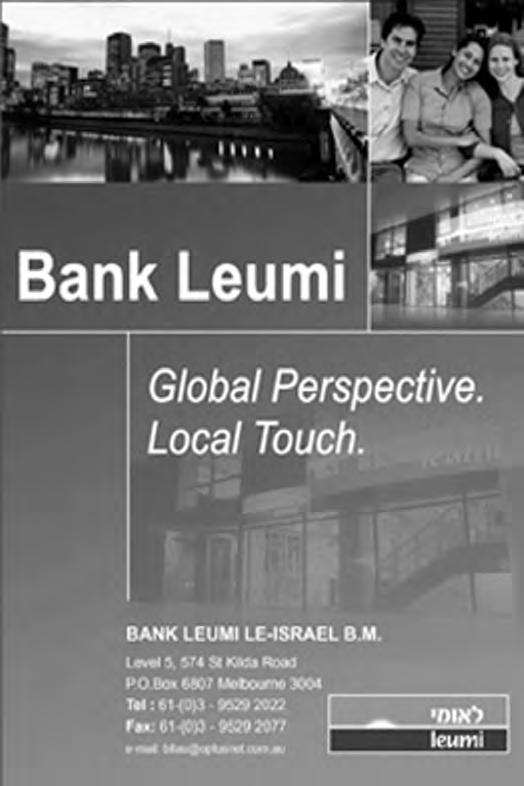
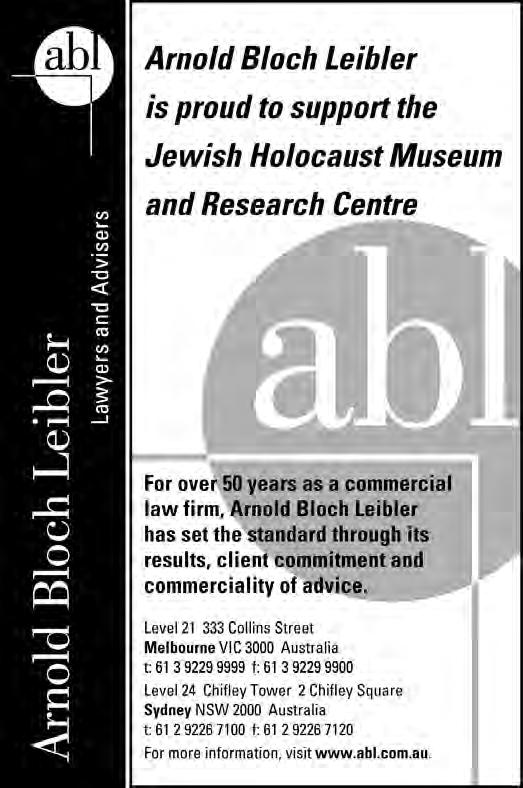


JHC Centre News 39 With Compliments KATZ SILVER LAWYERS Suite 1, 71 Kooyong Road, Caulfield North 3161 Ph: 8508 8300 Fax: 8508 8399 Conveyancing, Wills & Estate Leases, Litigation and Business Law

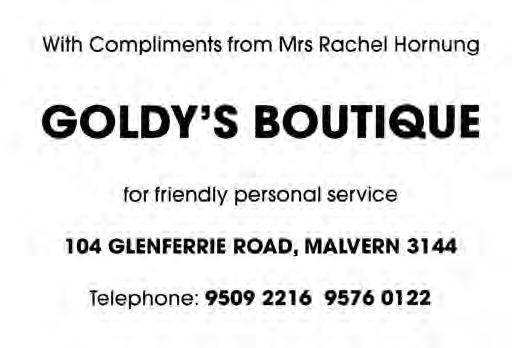



JHC Centre News 40
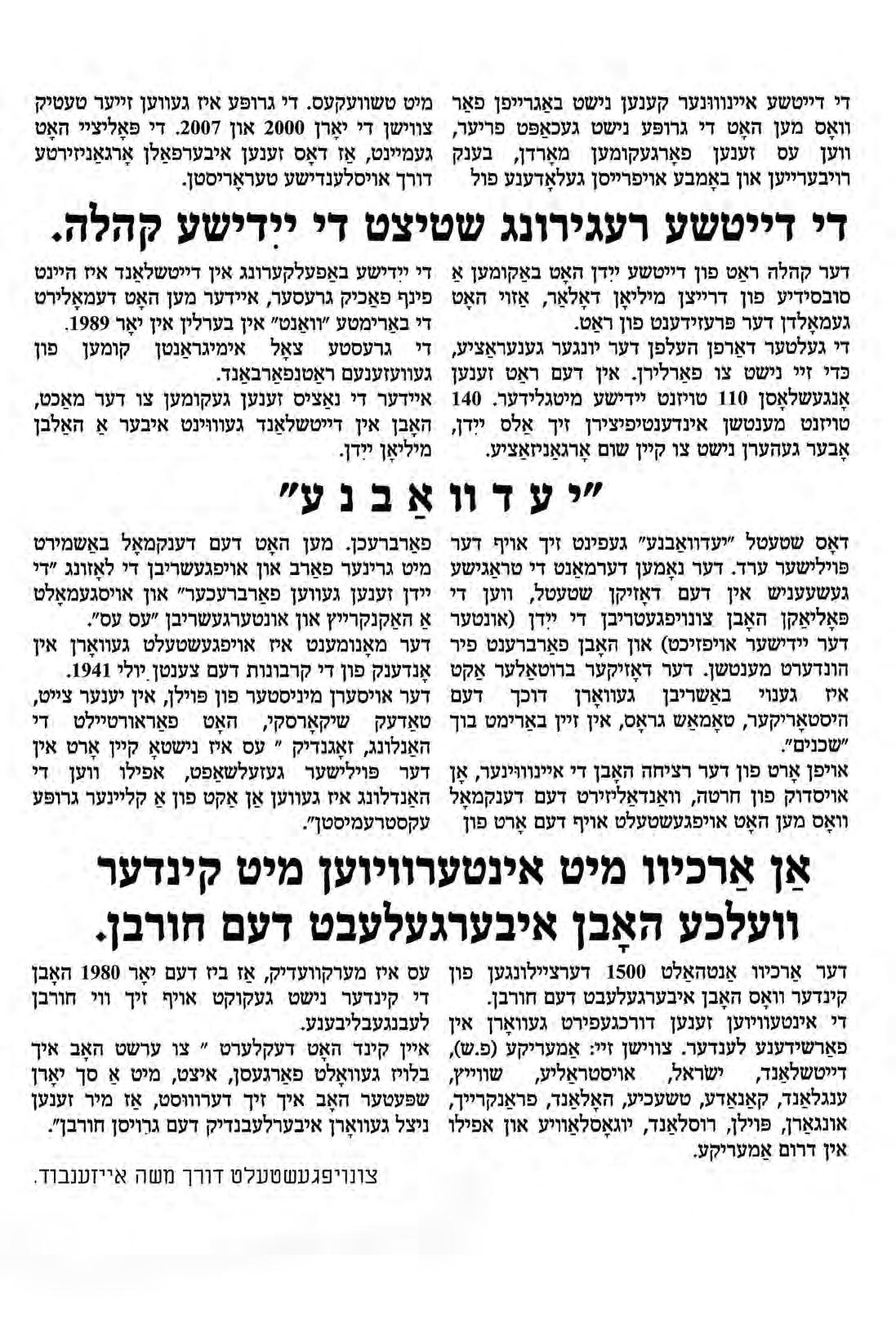
JHC Centre News 41

JHC Centre News 42
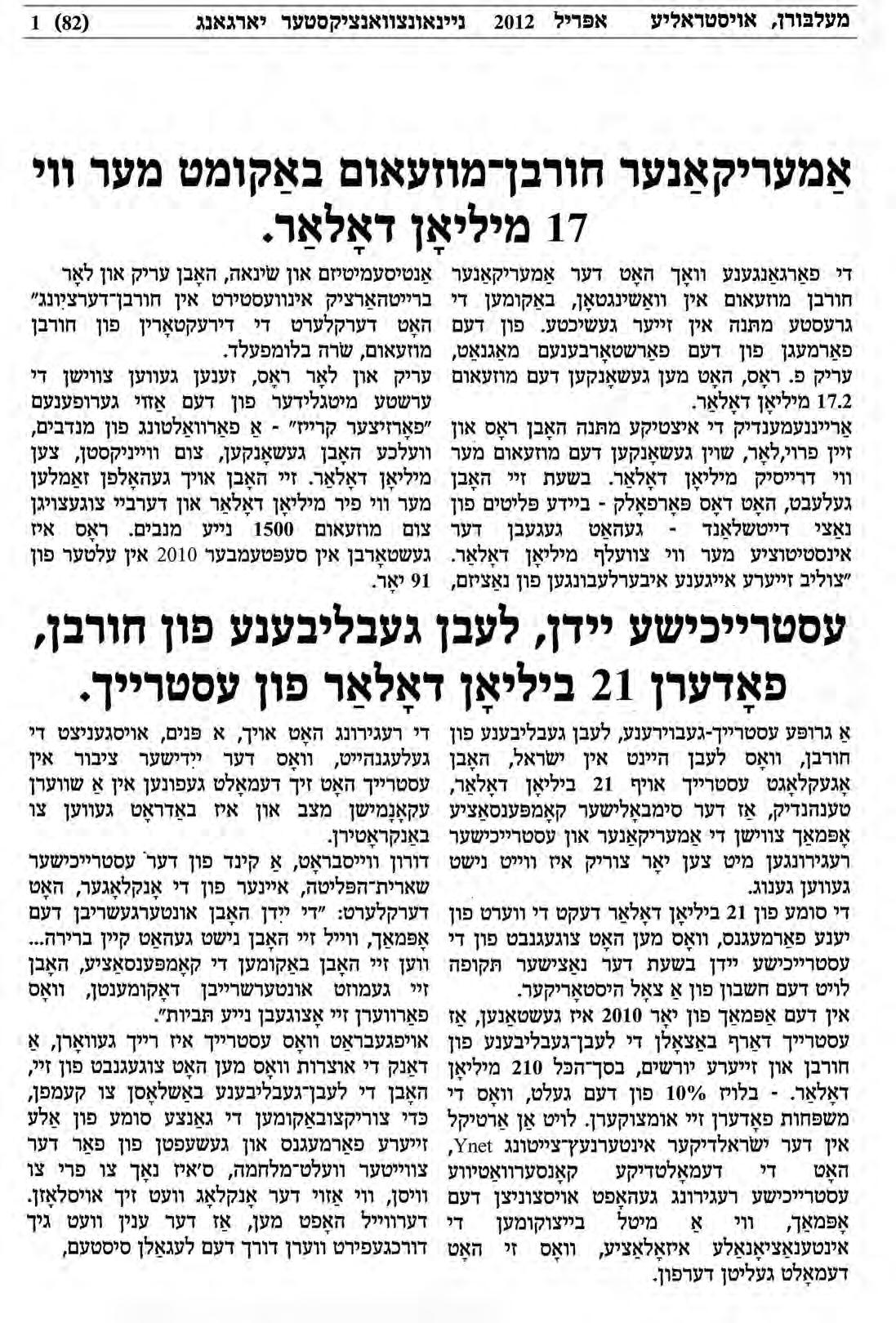
JHC Centre News 43
April 2012 Jewish Holocaust Centre
the rescuers
The Jewish Holocaust Centre (JHC) will present an exhibition of photographs and extraordinary stories from the Holocaust and from genocides in Bosnia-Herzegovina, Rwanda and Cambodia. The exhibition will open in late July.

The exhibition will present the remarkable stories of ordinary heroes who resisted overwhelming tides of prejudice and violence and risked their lives to save others from enemy groups.
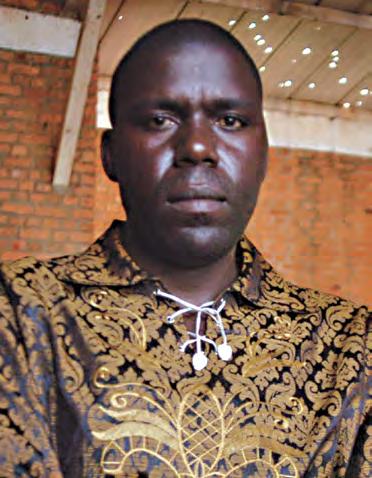
Leora Kahn (USA), creator of the exhibition, will open the exhibition and conduct a series of lectures relating to genocide and rescue. The JHC will also host a series of lectures and discussions involving academics and leading members of the Jewish community, and other communities affected by genocide.

The exhibition will continue the important work of the JHC as an institution committed to combating racial intolerance, bigotry and prejudice.
Exhibition details will be available on the JHC website www.jhc.org.au in the coming weeks.
Registered by Australia Post. Publication No. VBH 7236
Leora Kahn
Silas Ntamfurigirishyari, a Rwandan rescuer






























































 A Jewish woman walks towards the gas chambers with three young children, May 1944. Photographer: Bernhardt Walter/Ernst Hofmann.
Source: US Holocaust Memorial Museum, courtesy of Yad Vashem
A Jewish woman walks towards the gas chambers with three young children, May 1944. Photographer: Bernhardt Walter/Ernst Hofmann.
Source: US Holocaust Memorial Museum, courtesy of Yad Vashem








 Eve Recht
Eve Recht





















